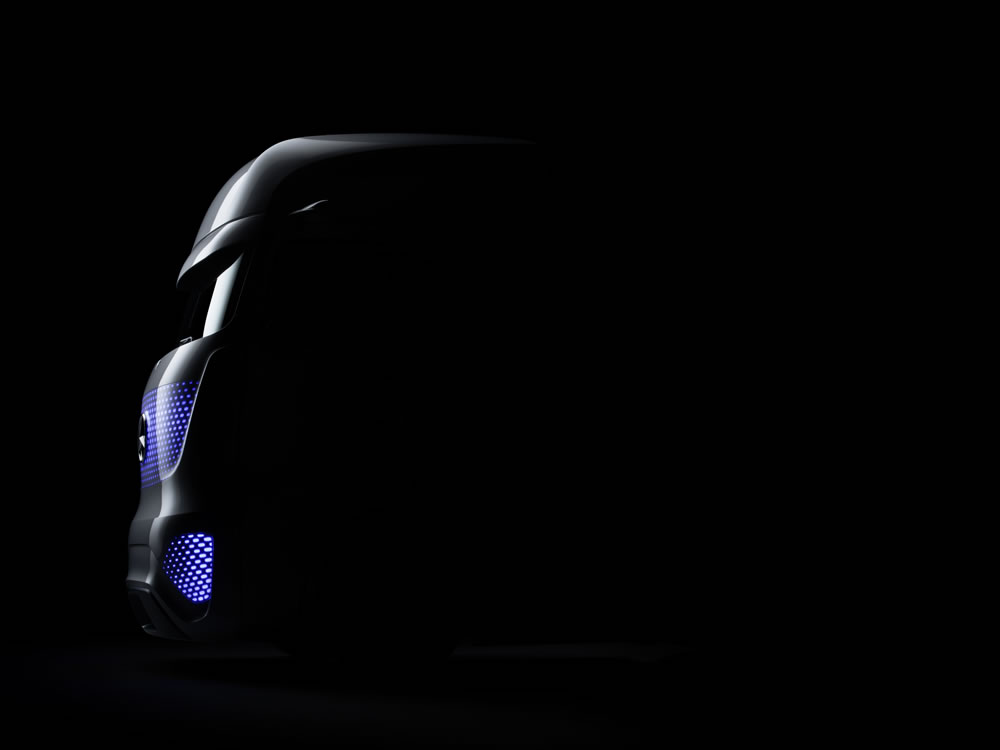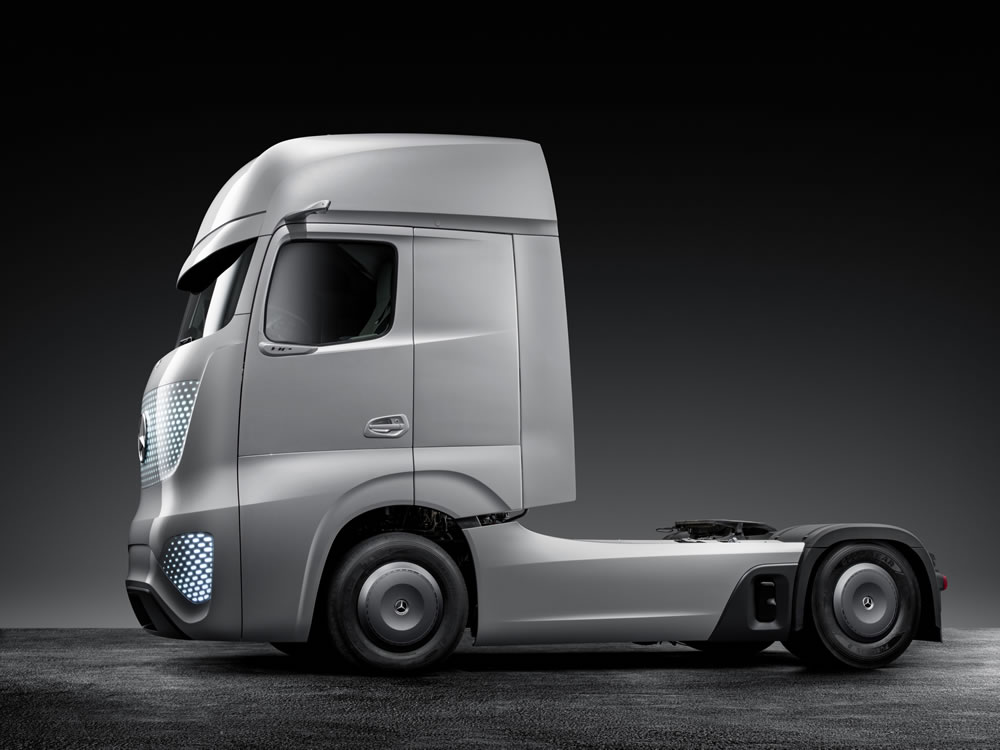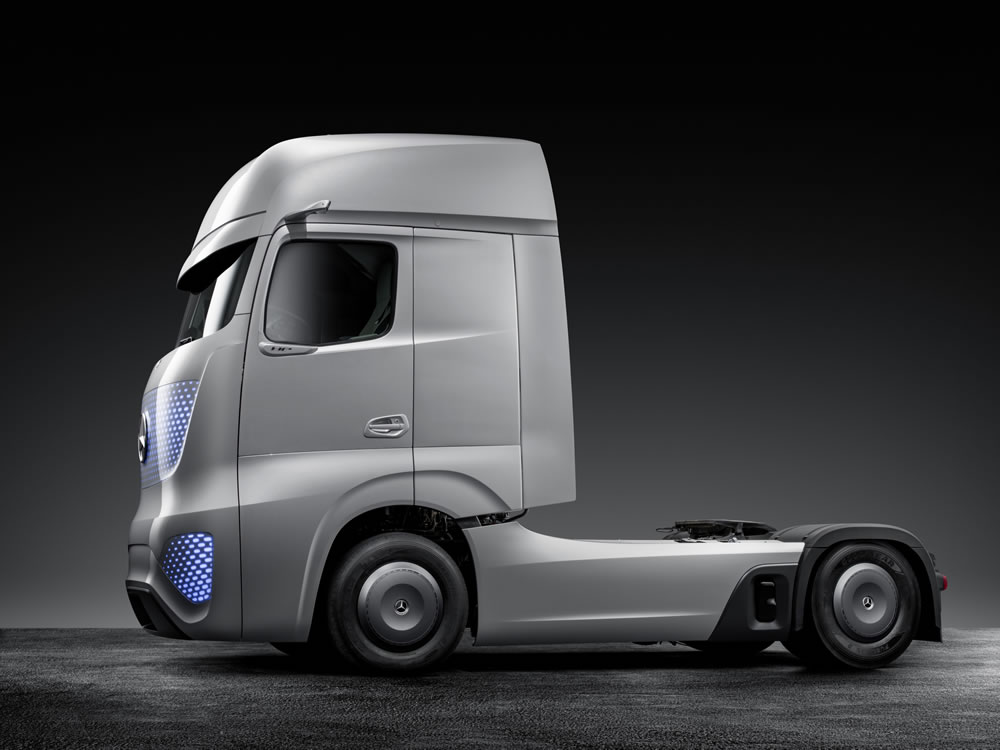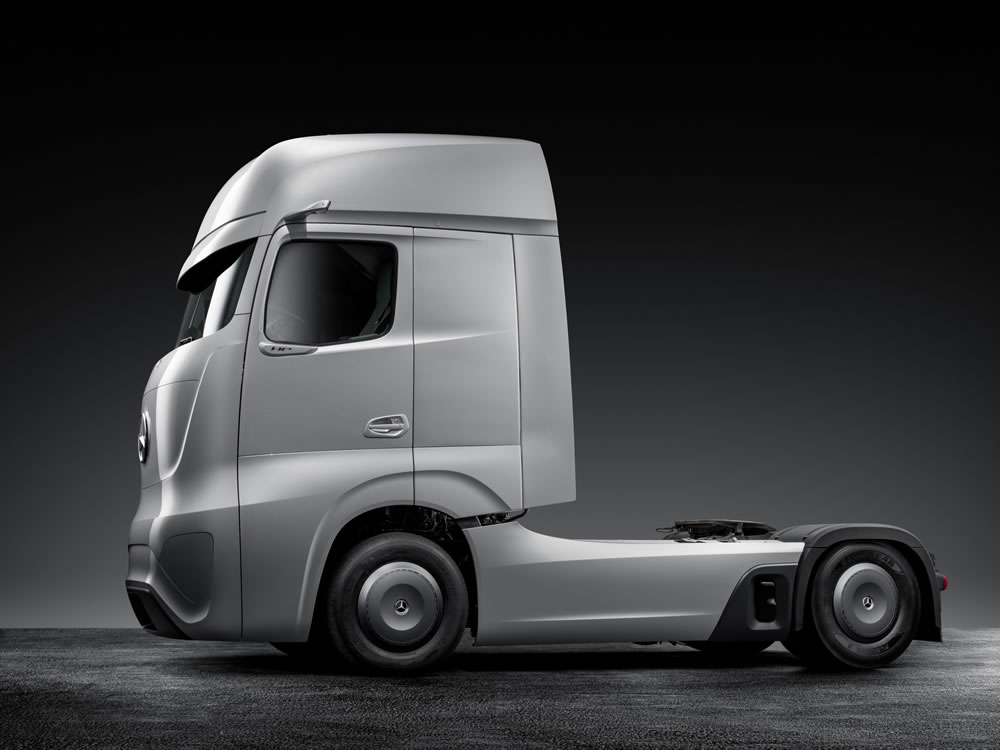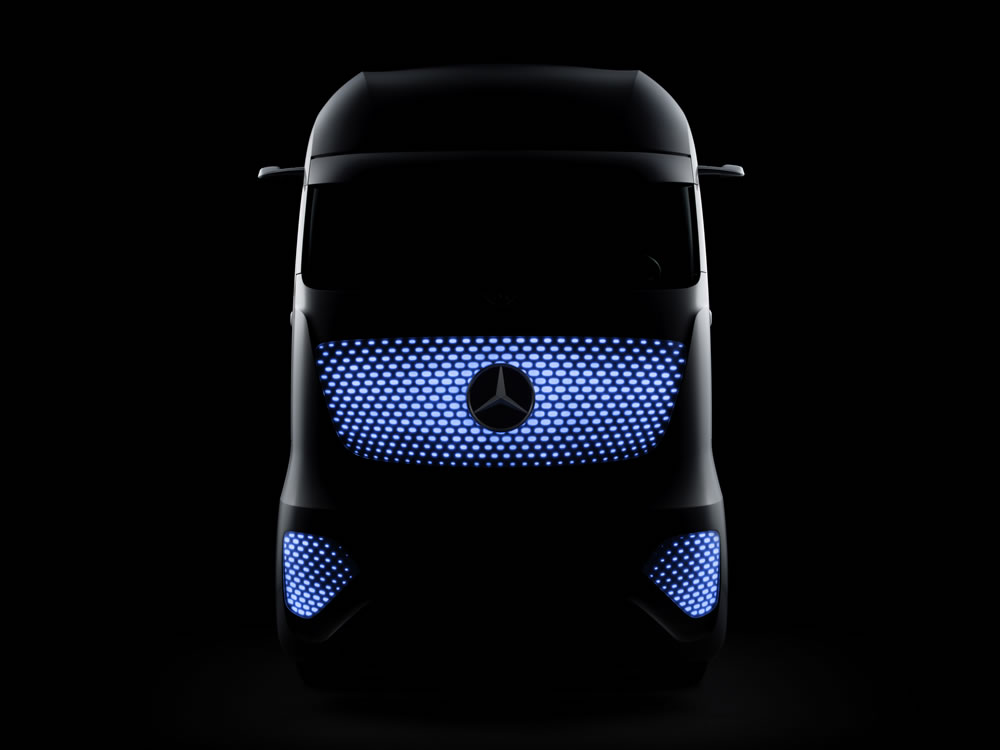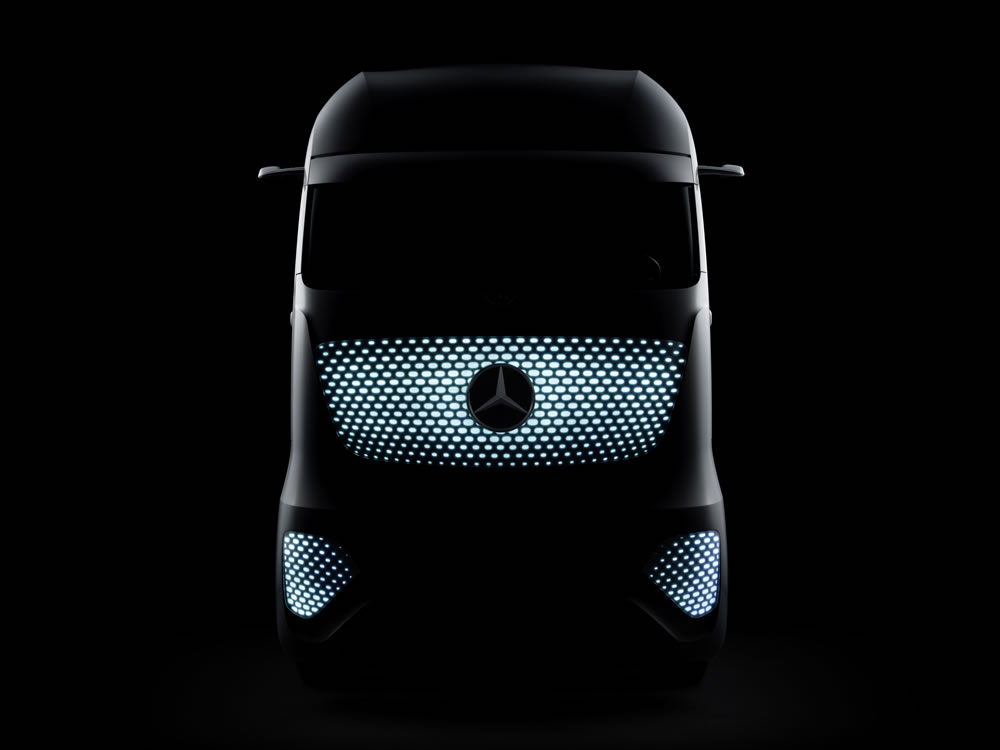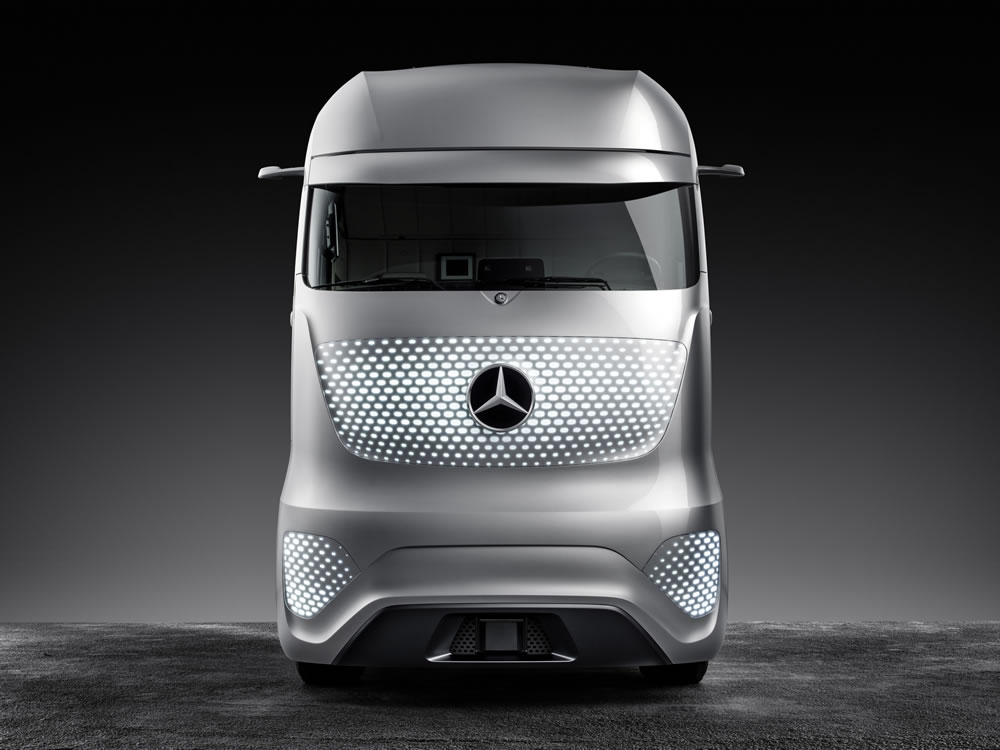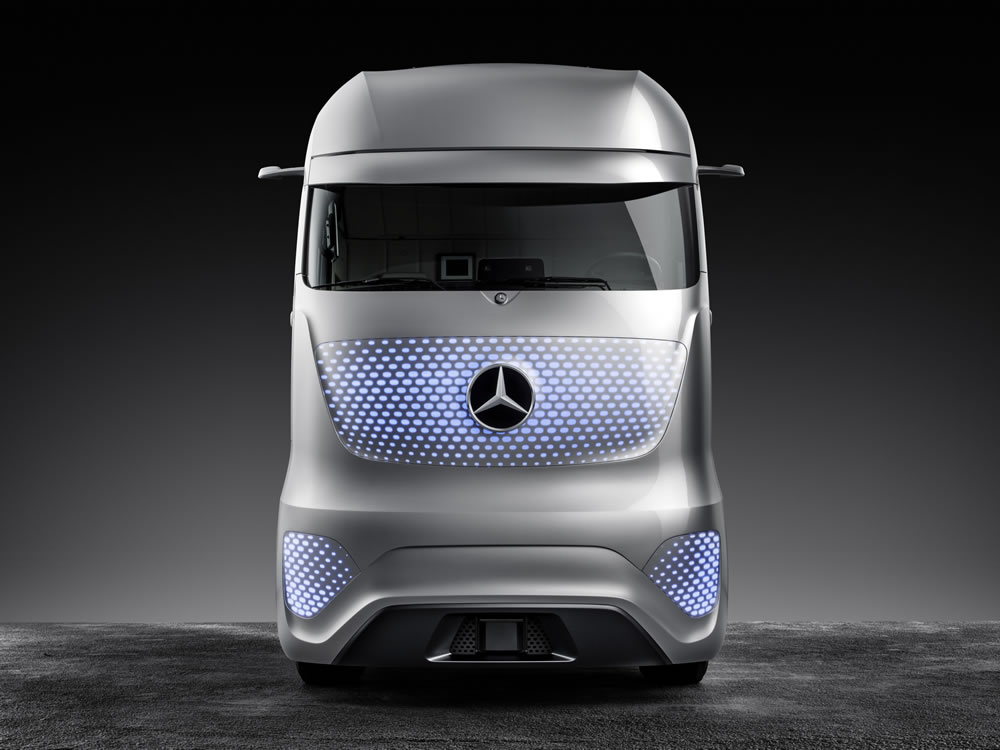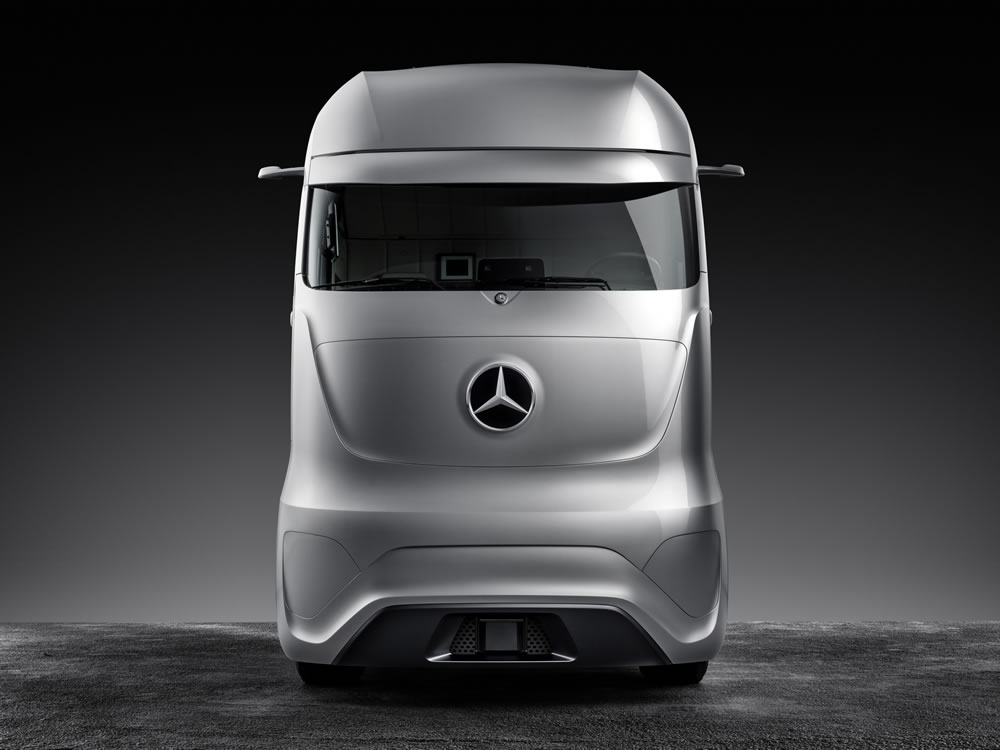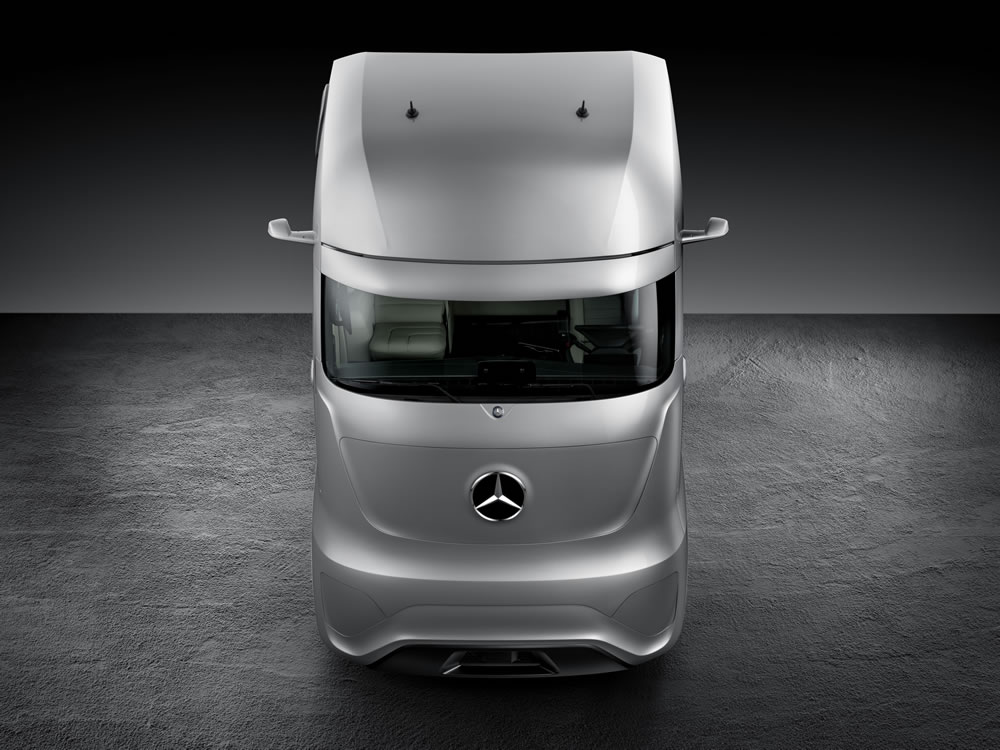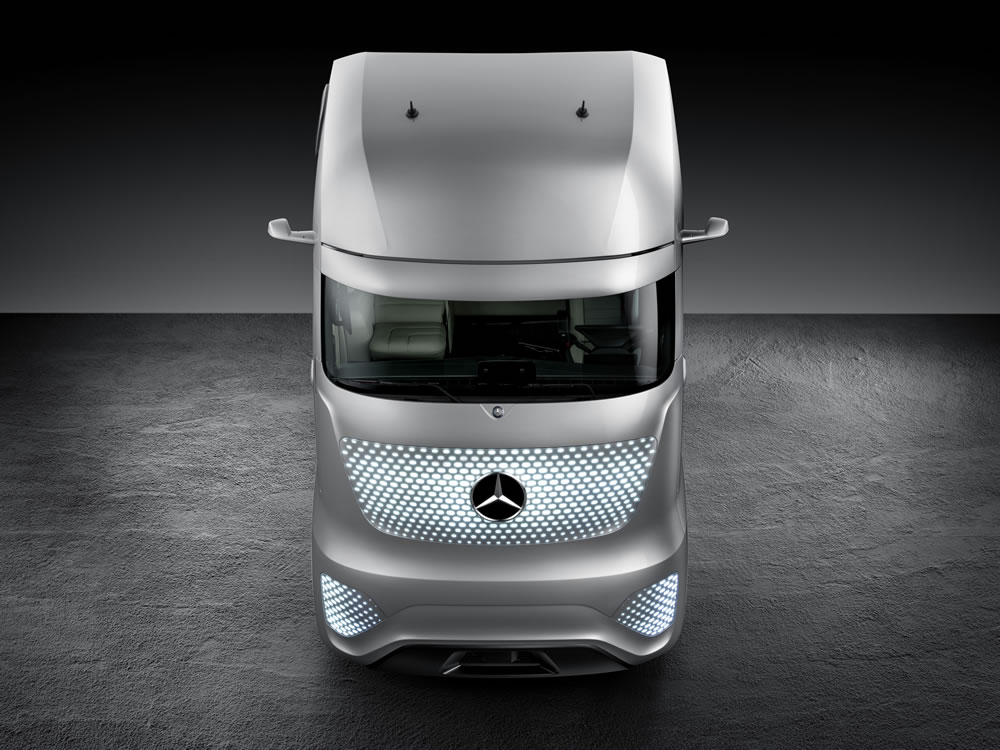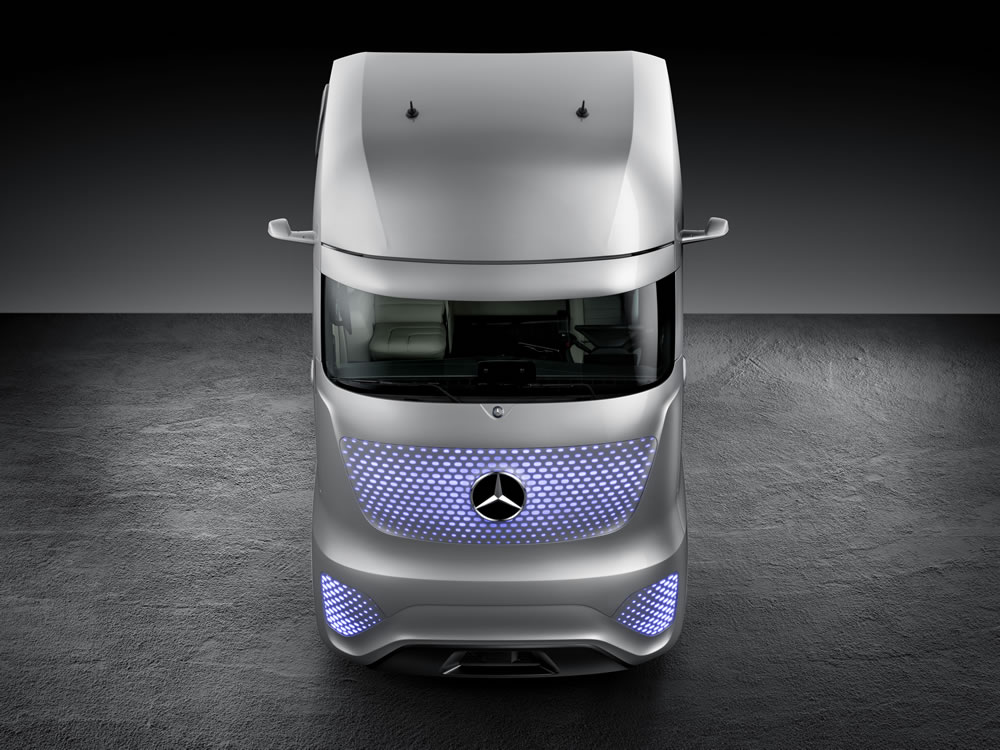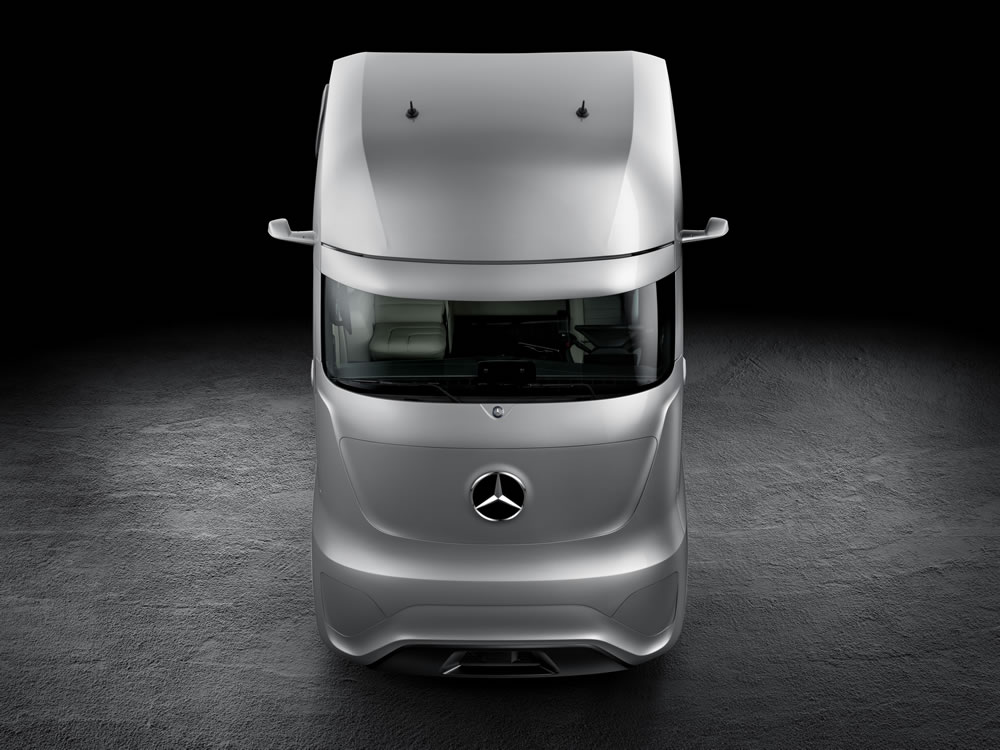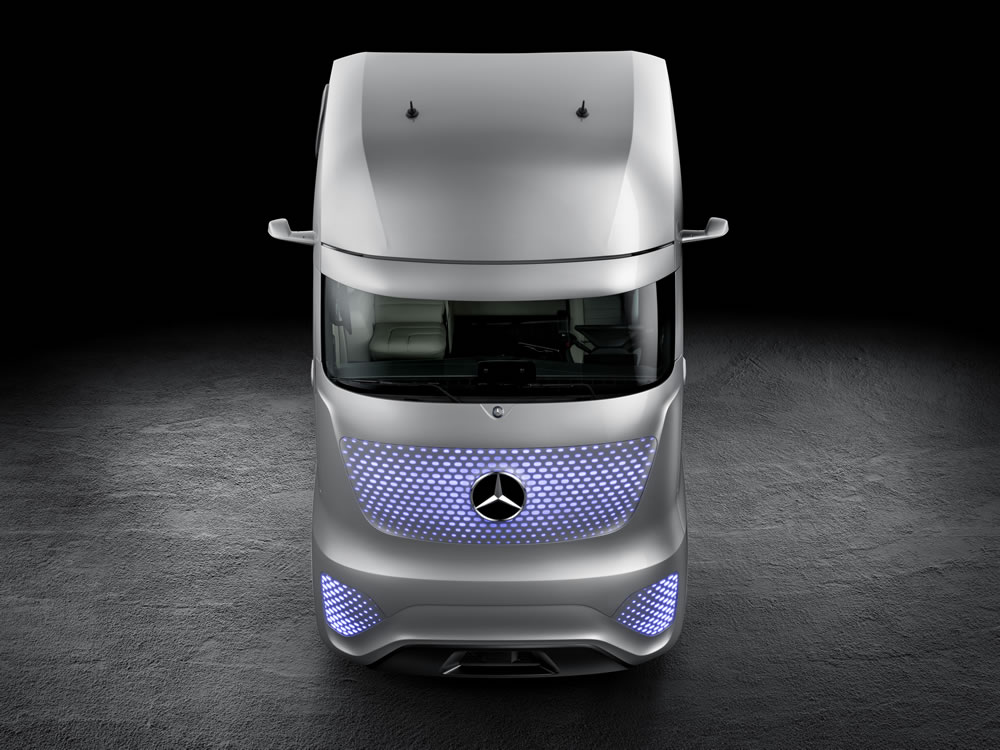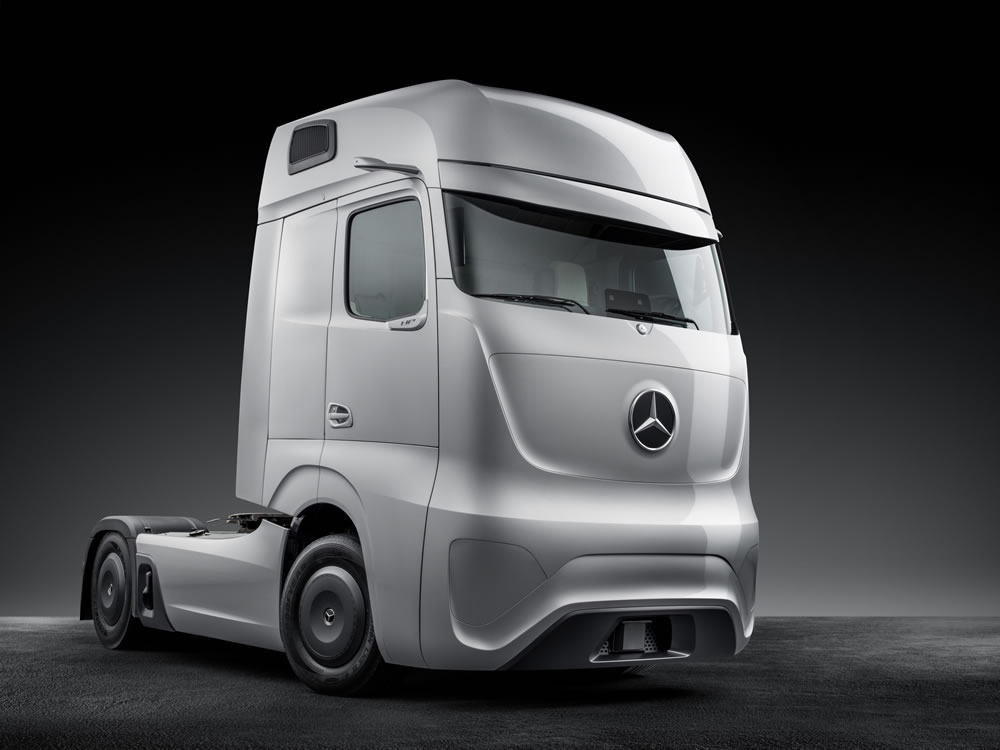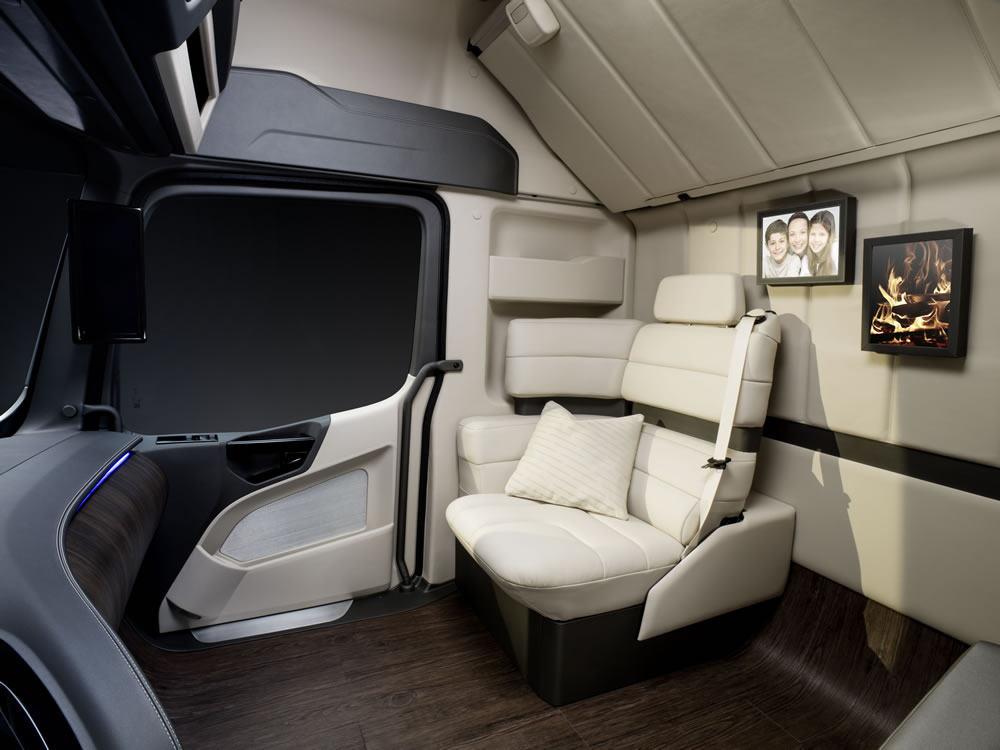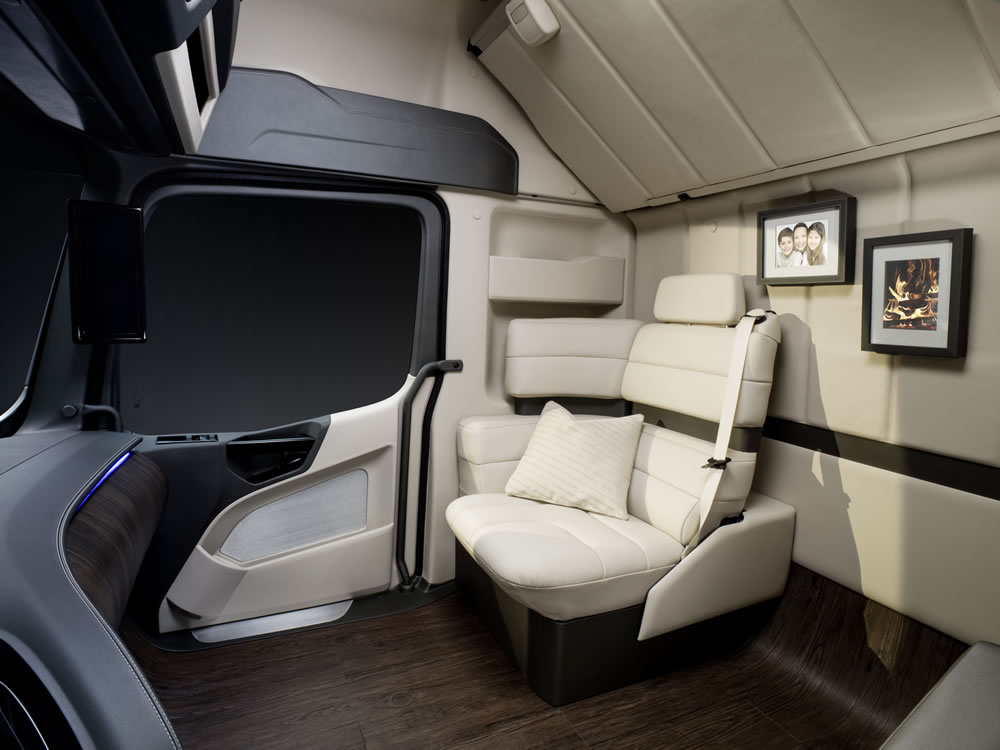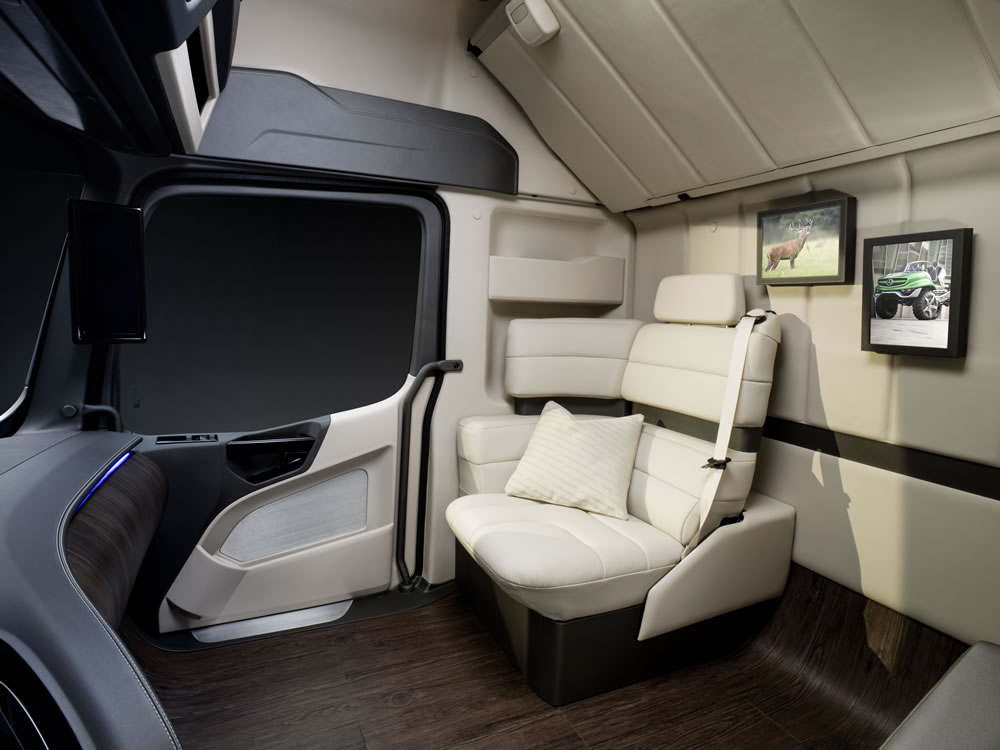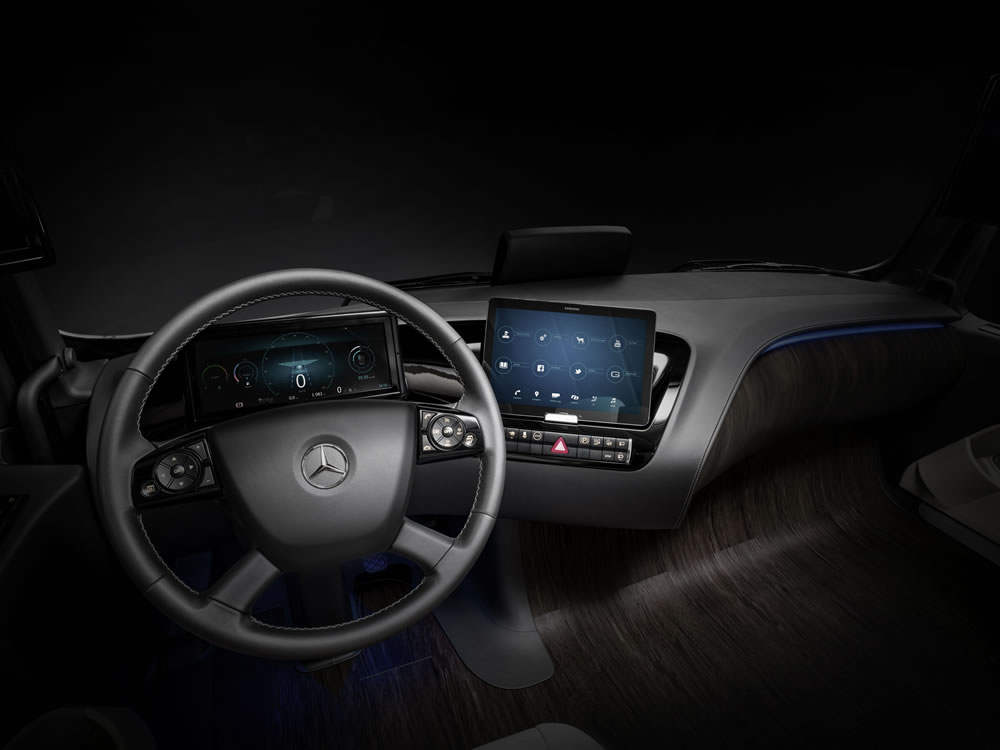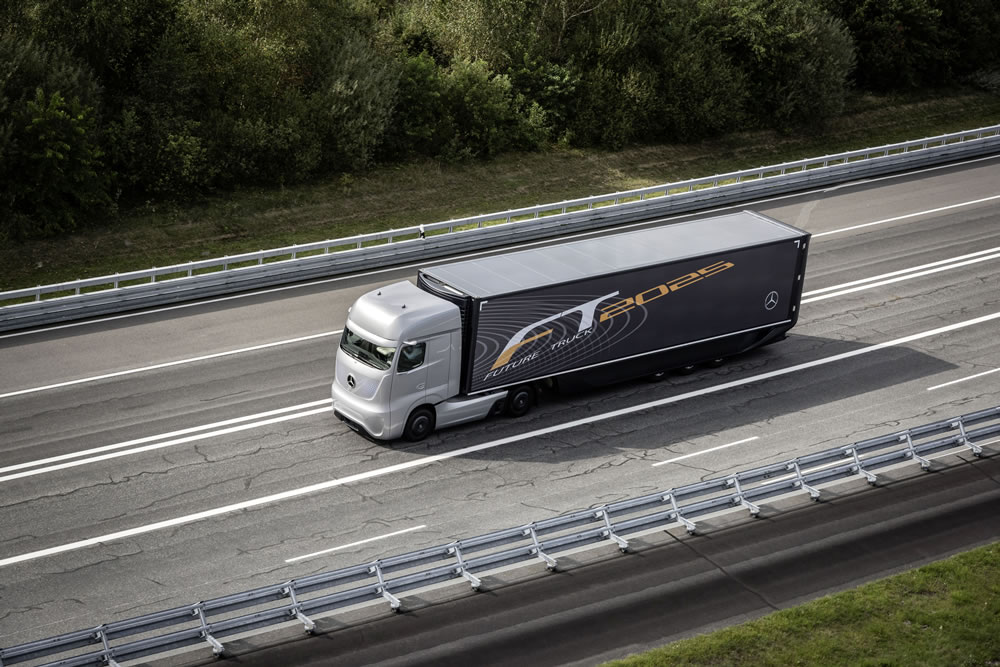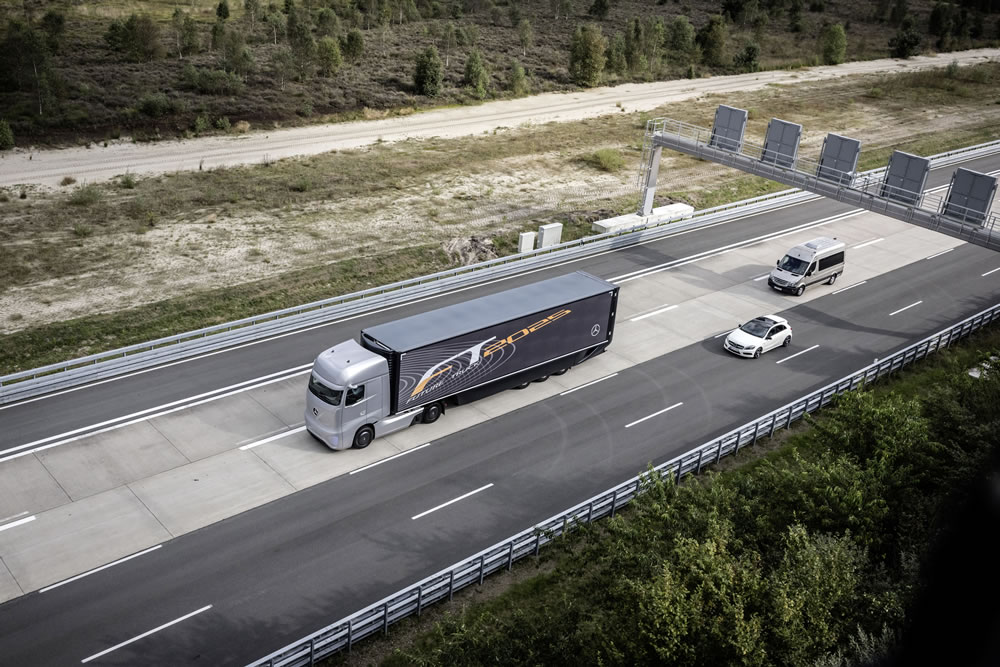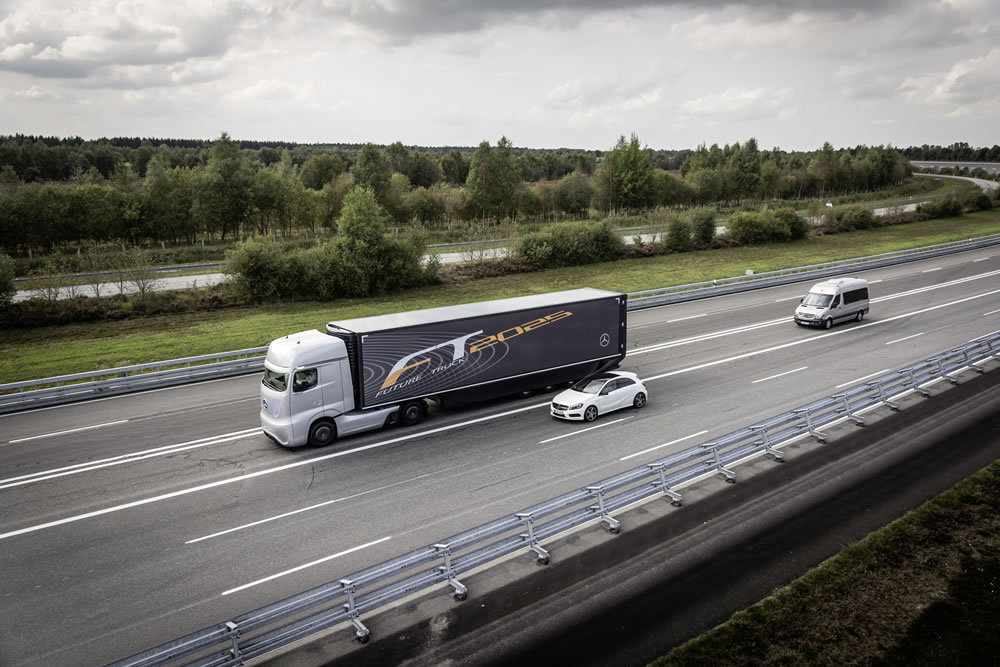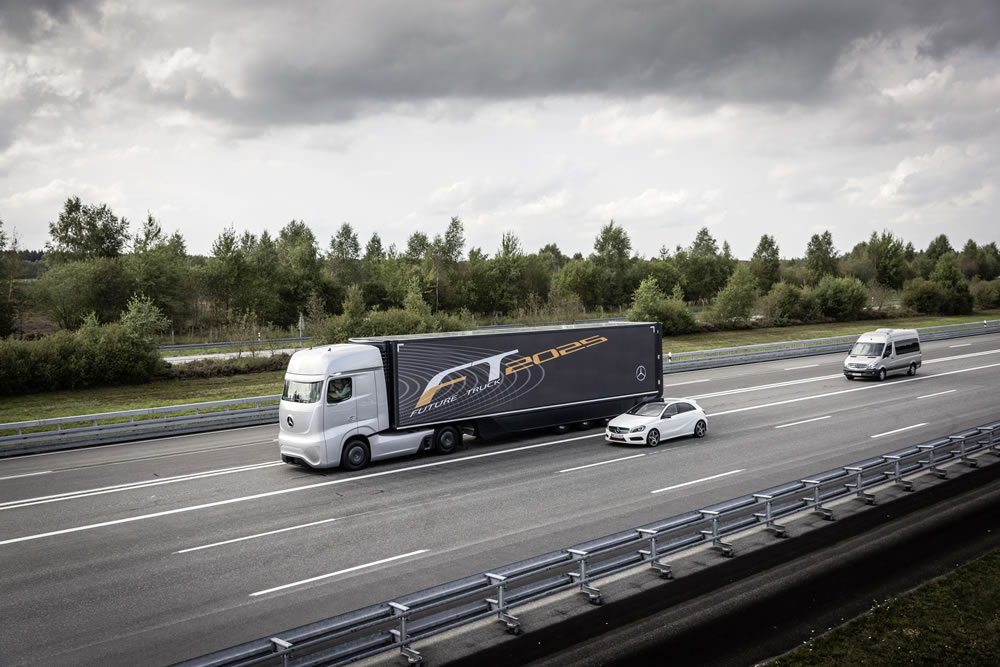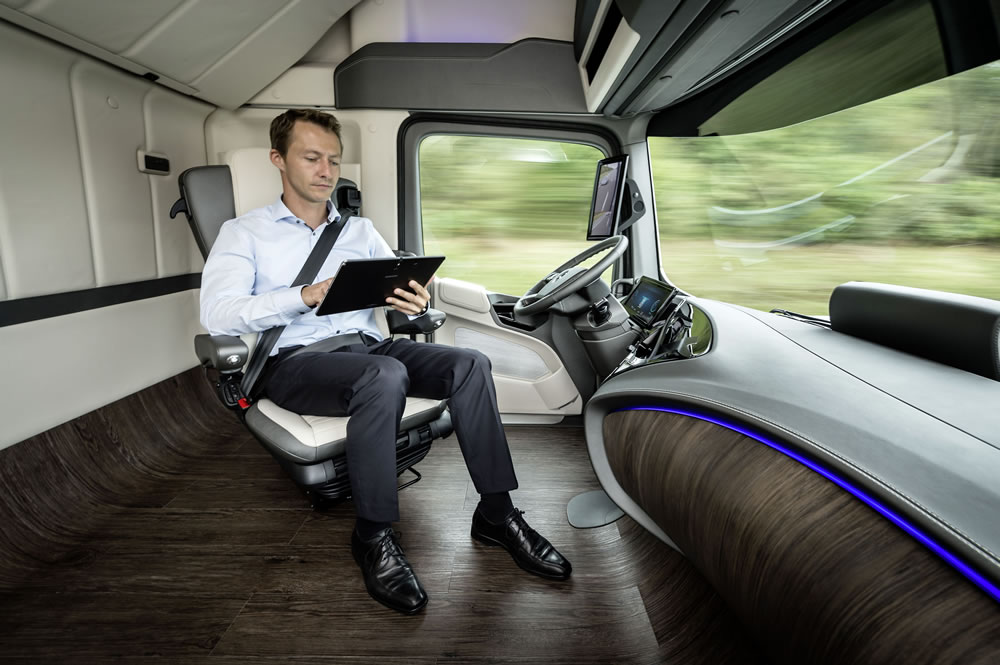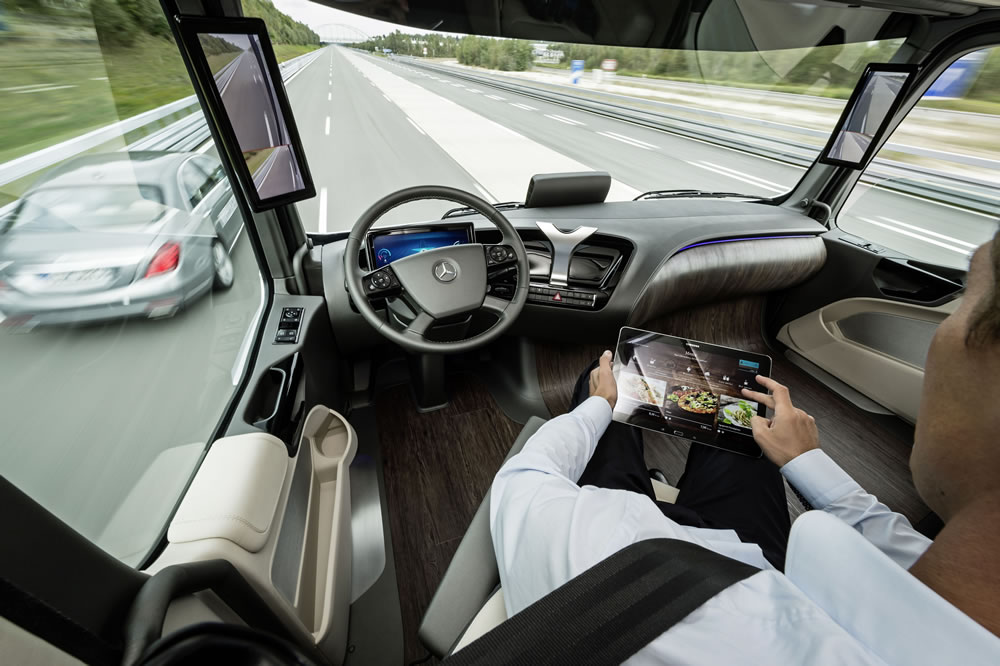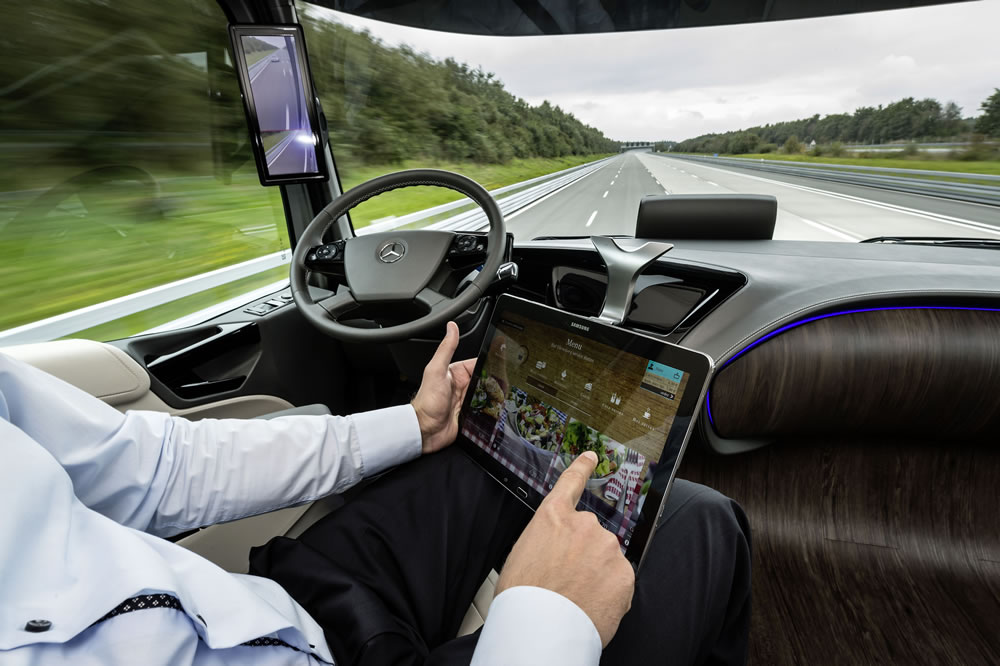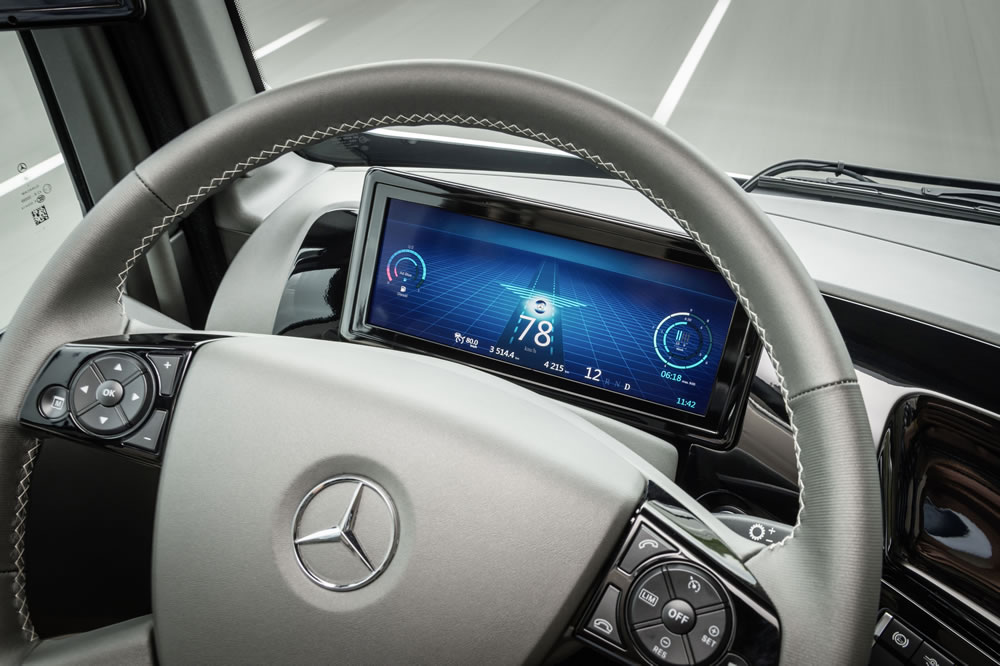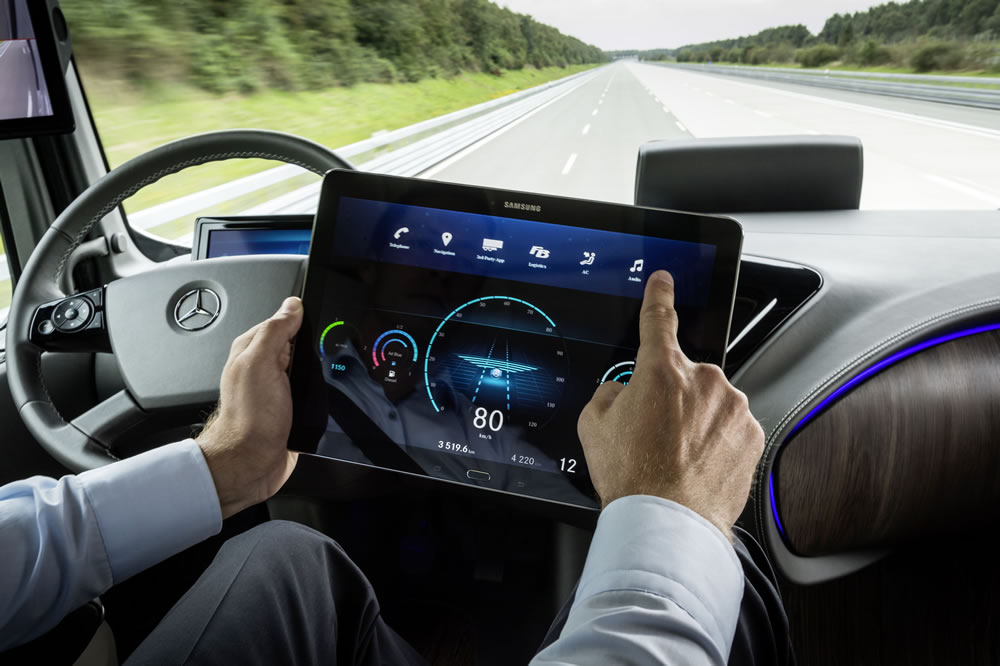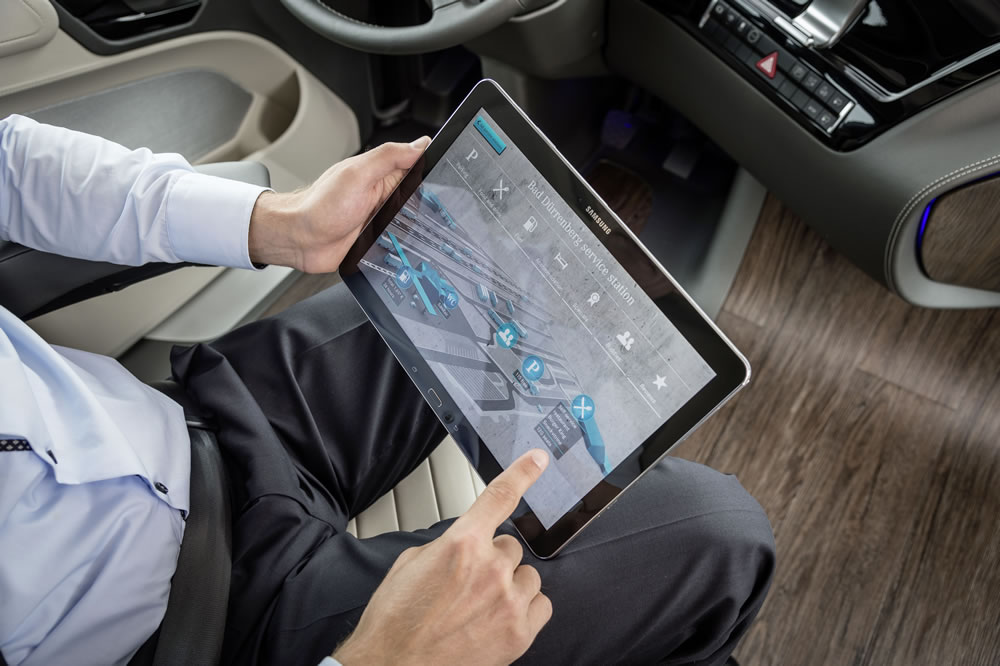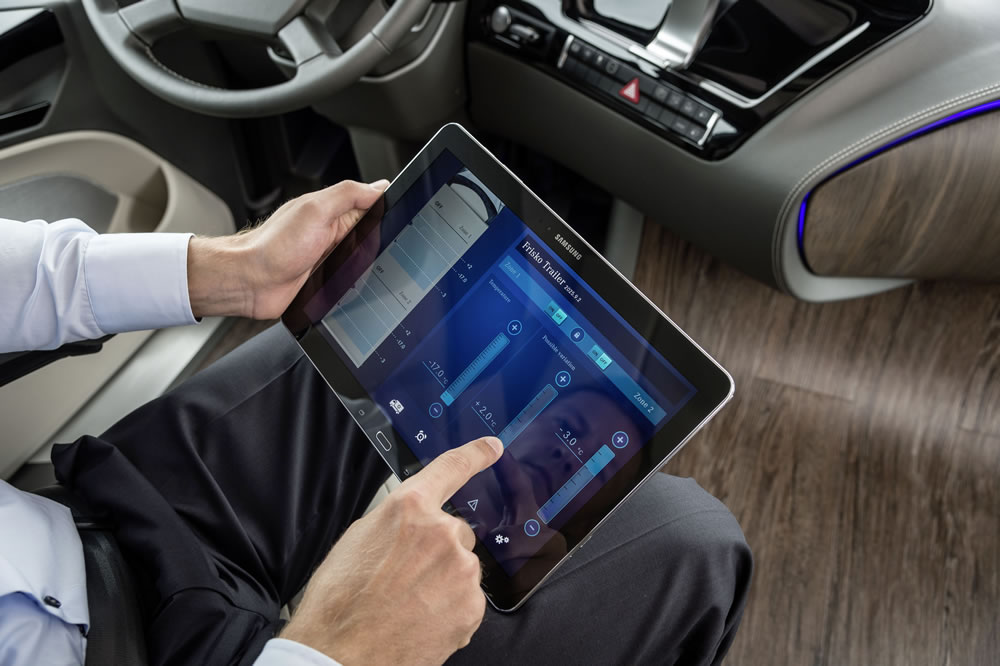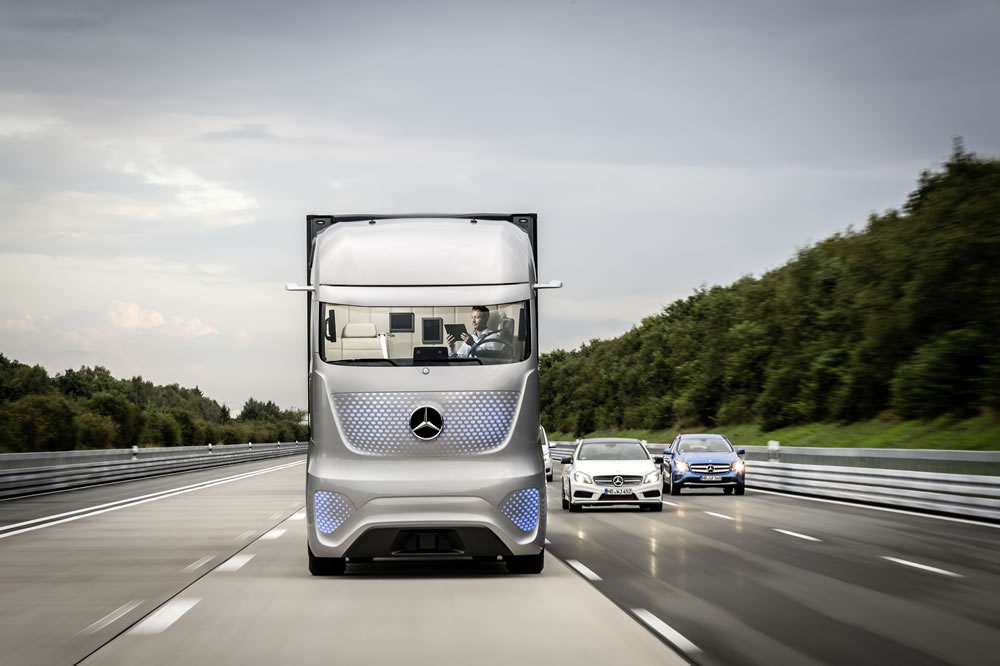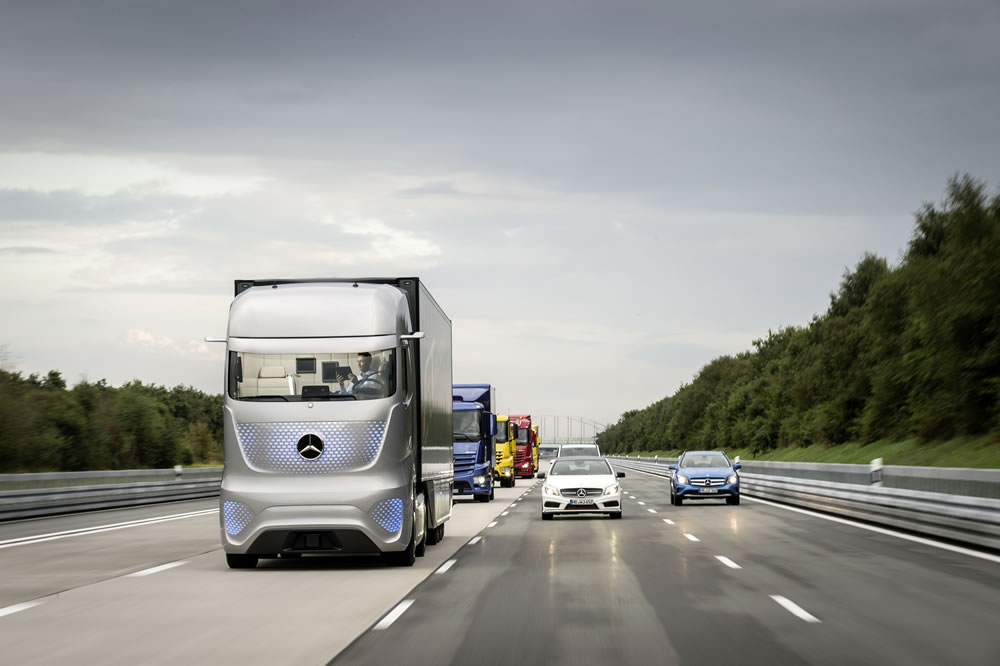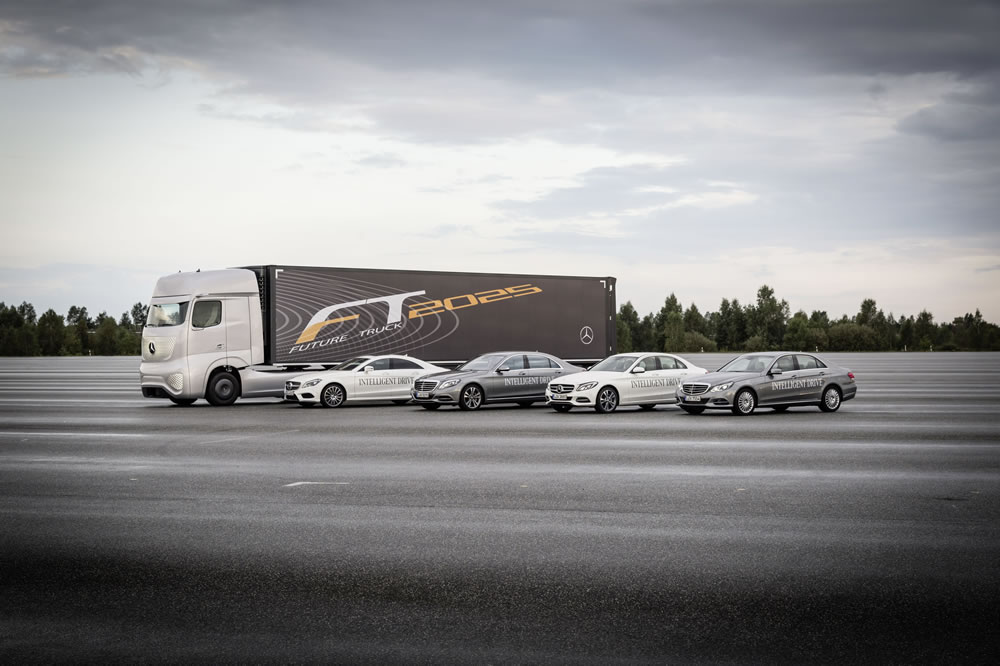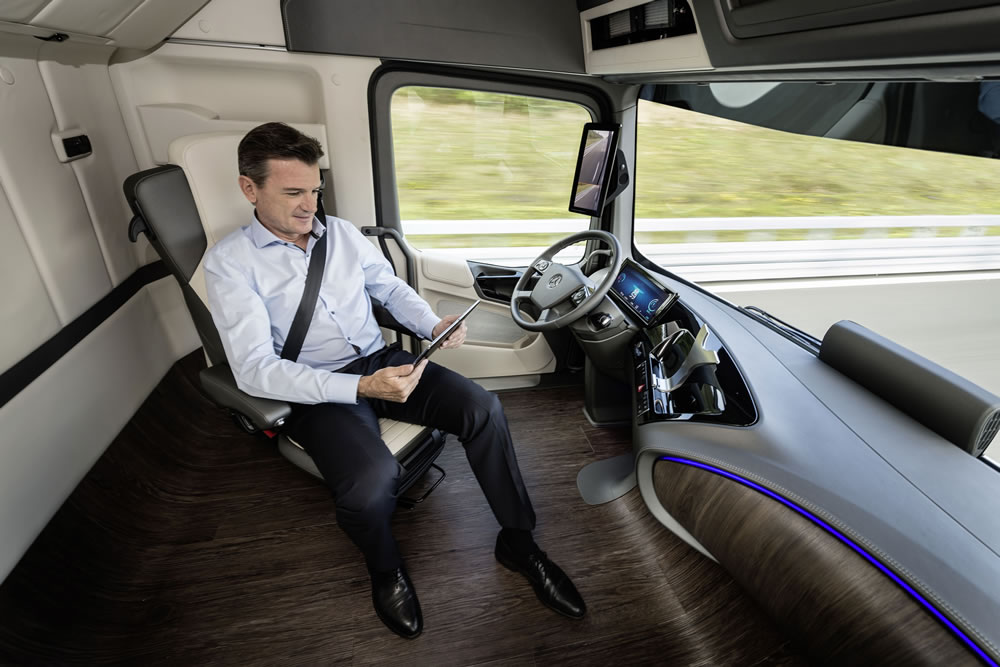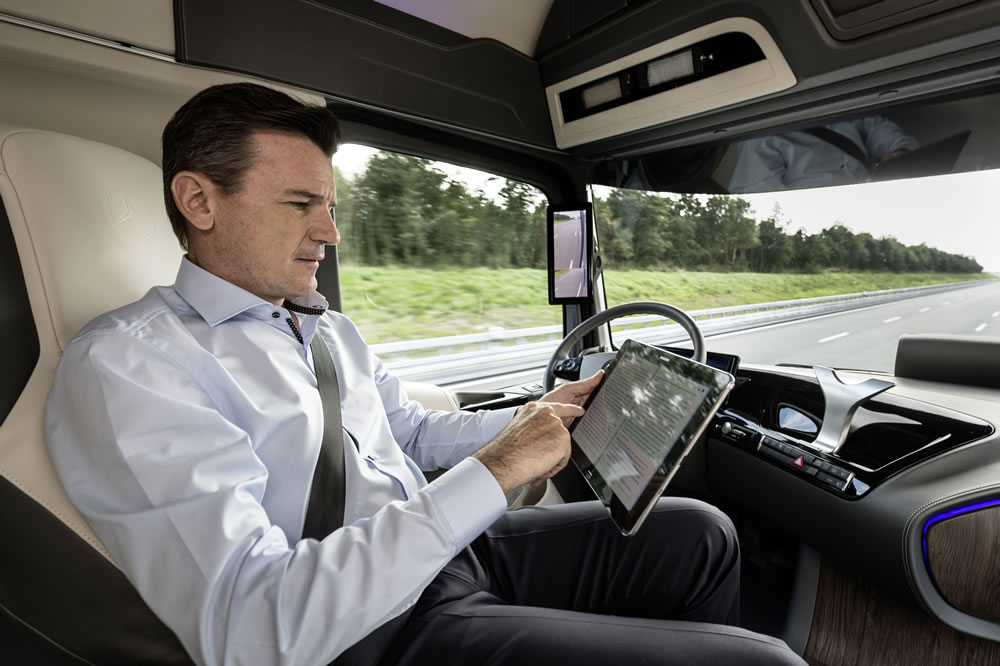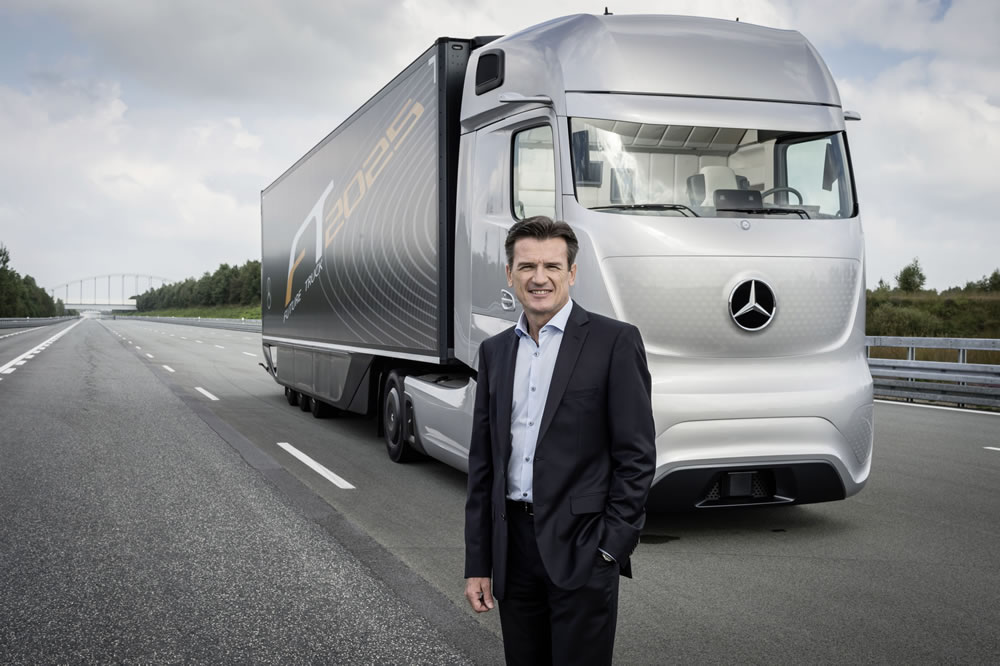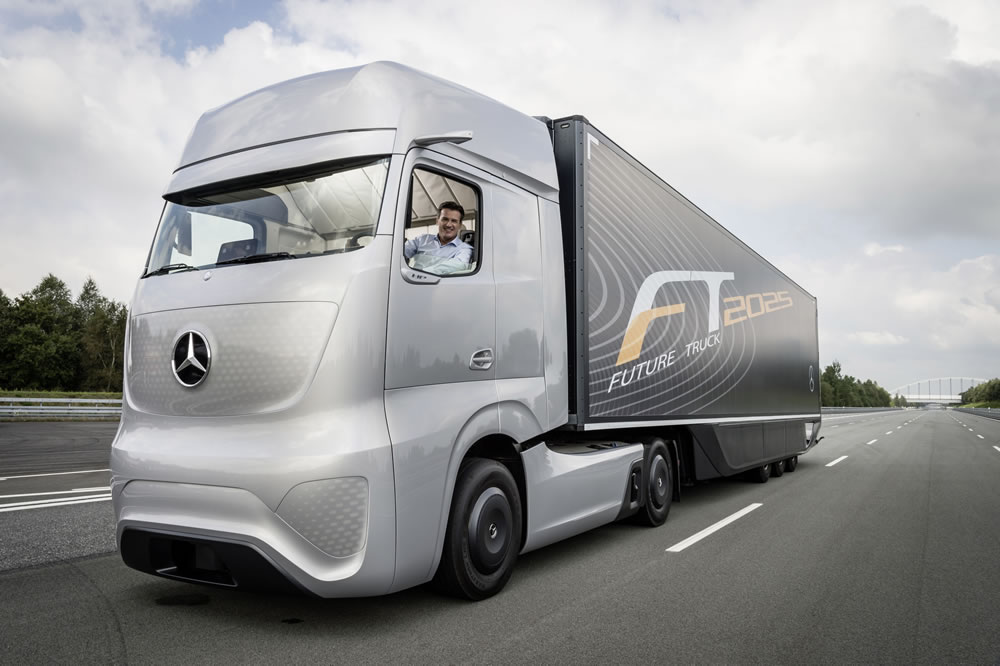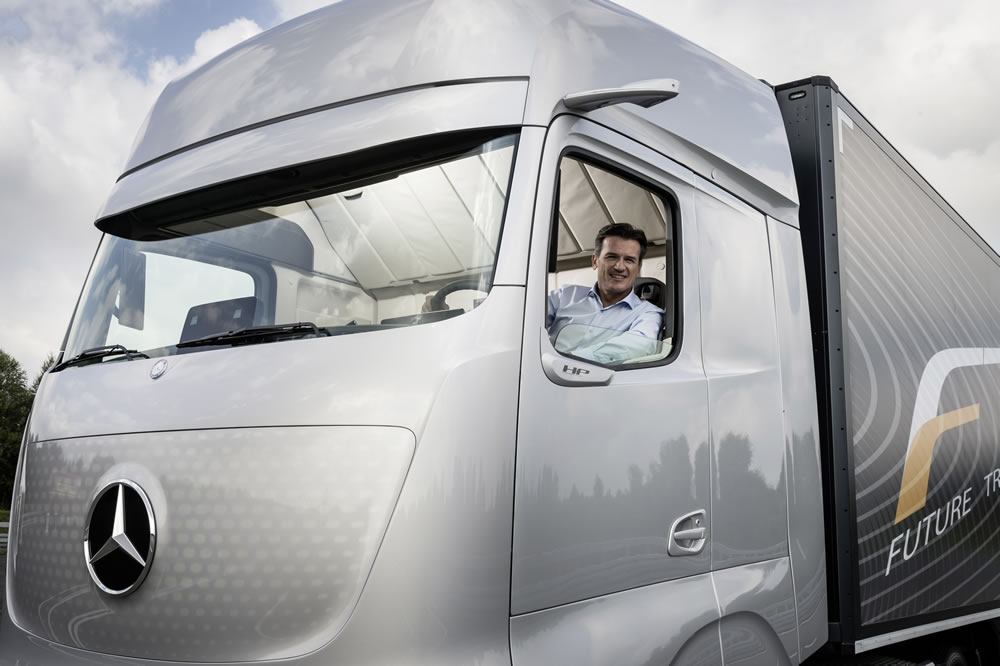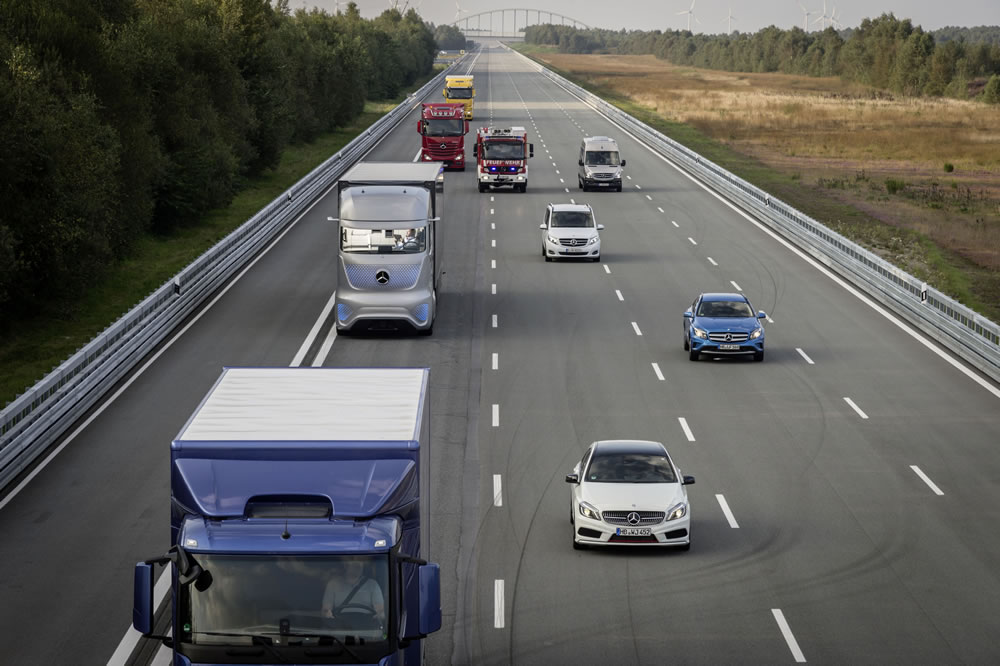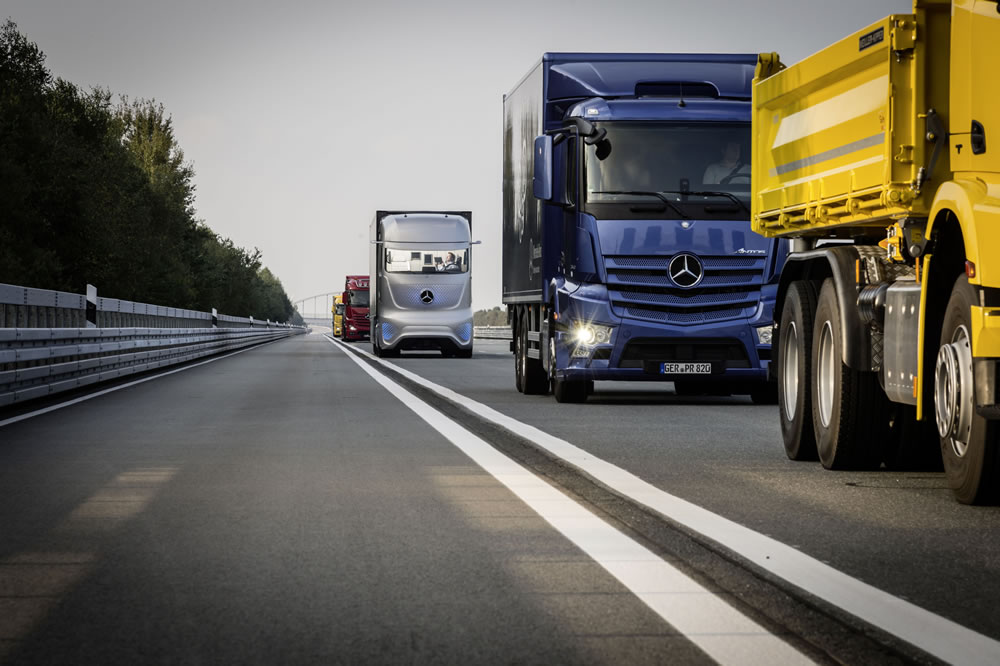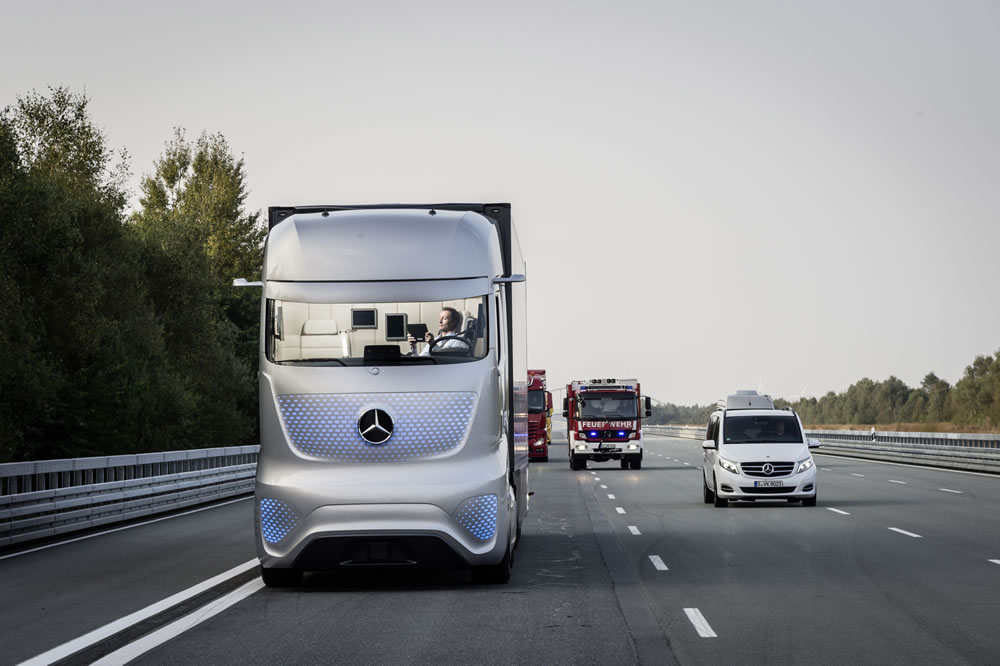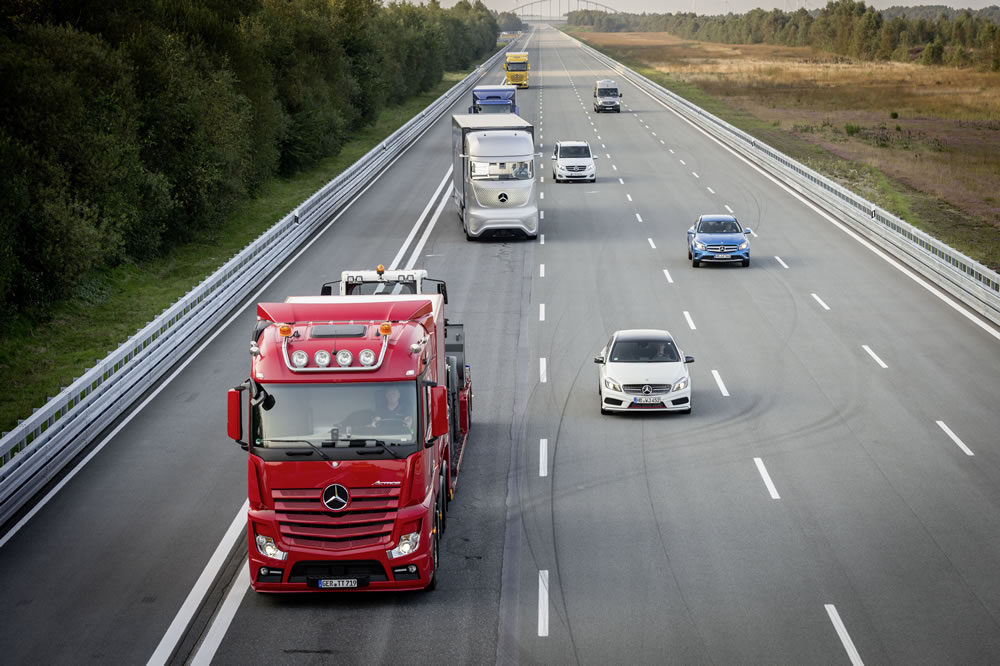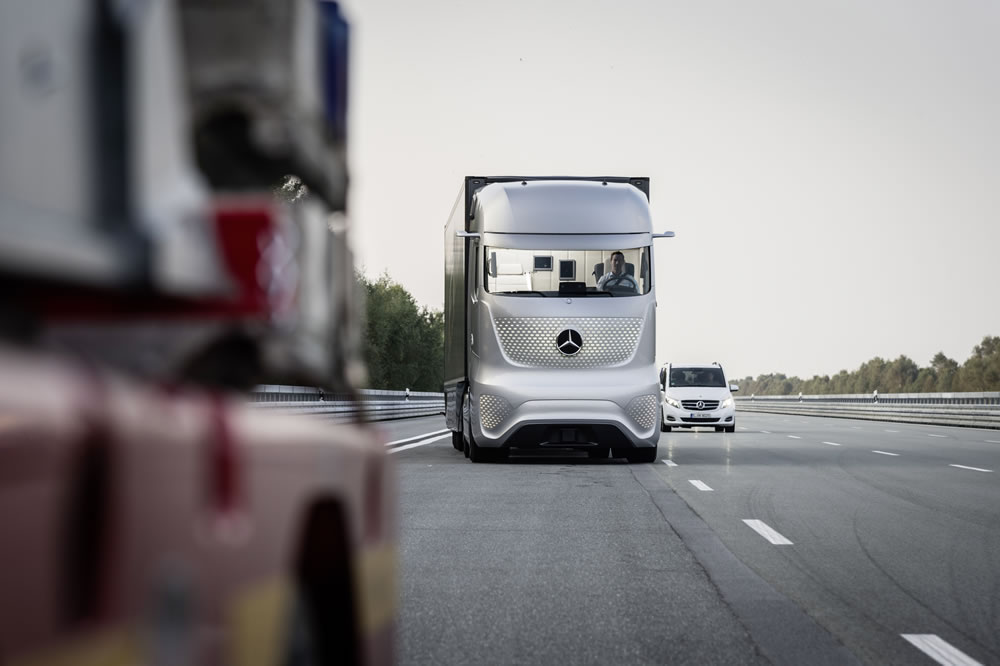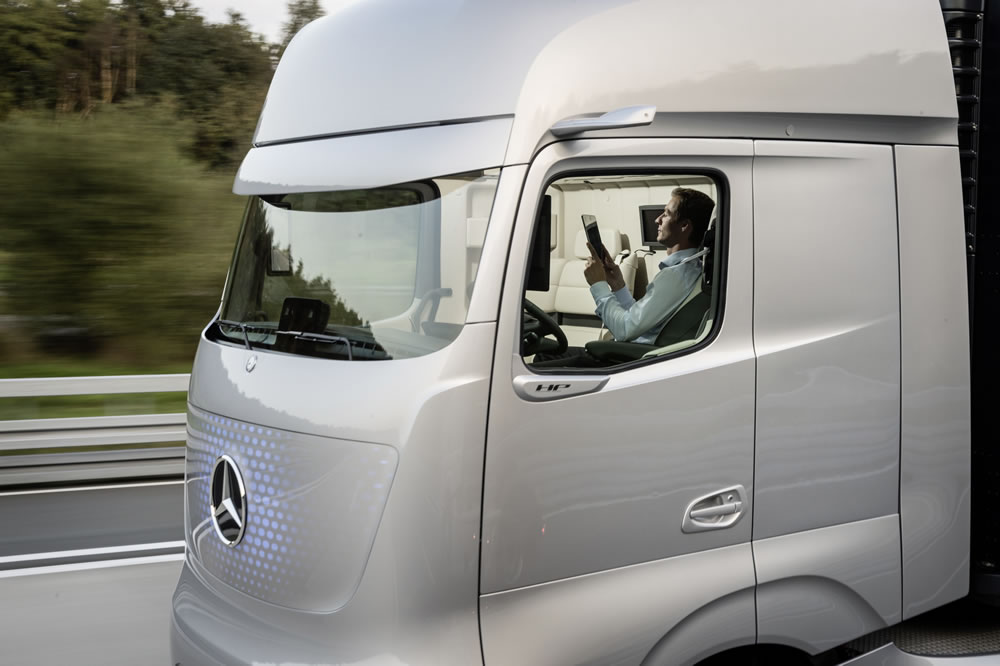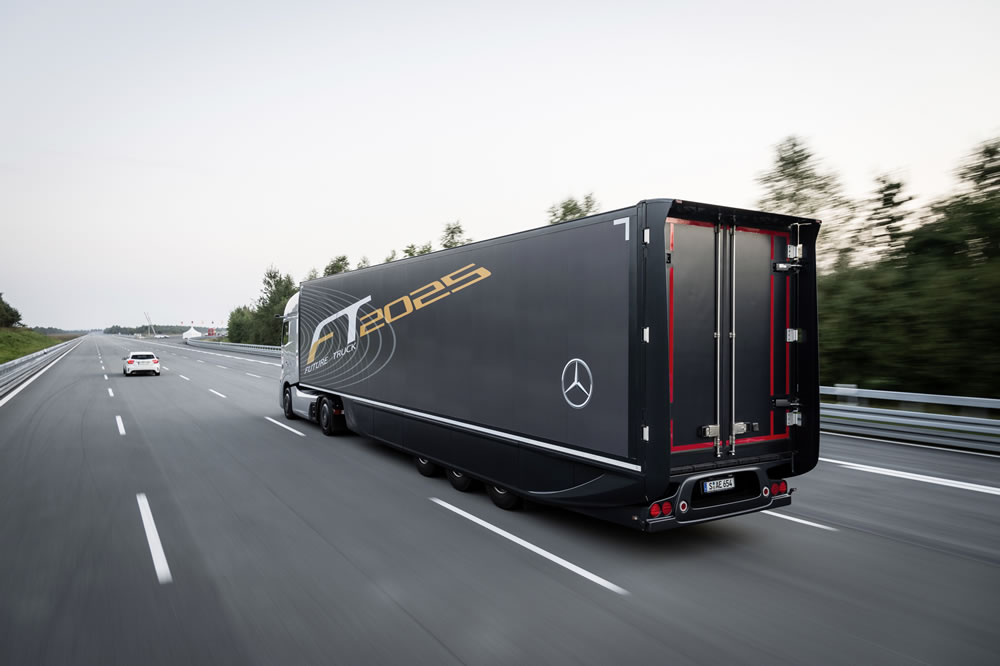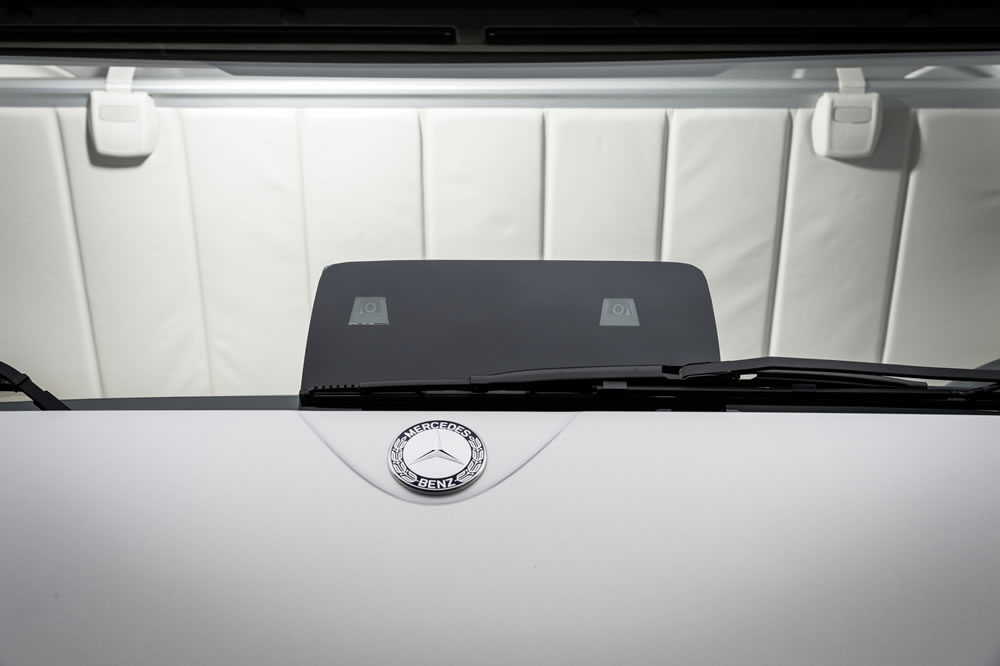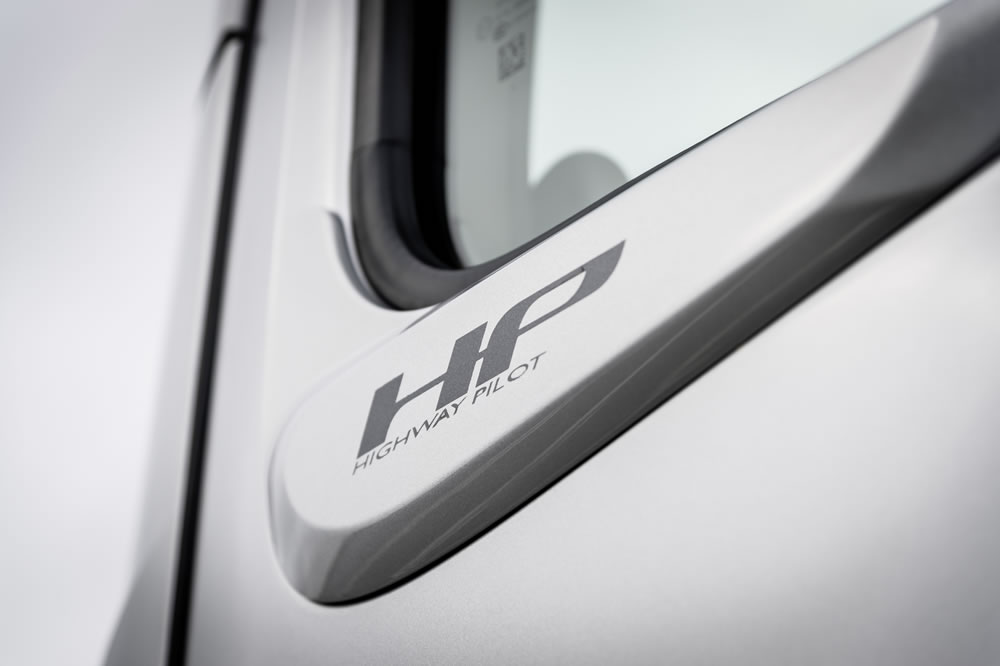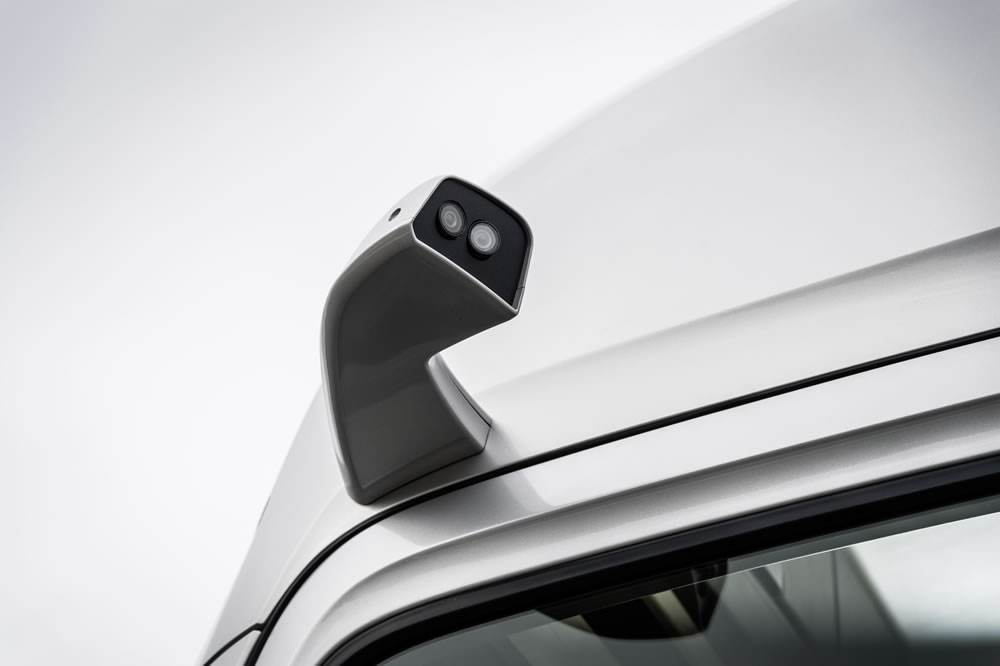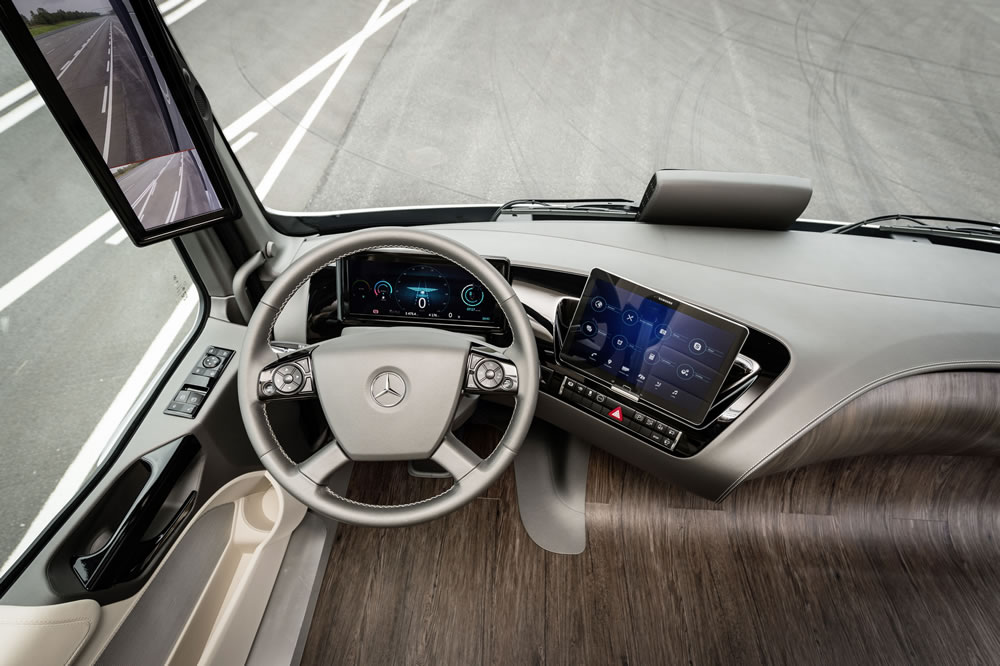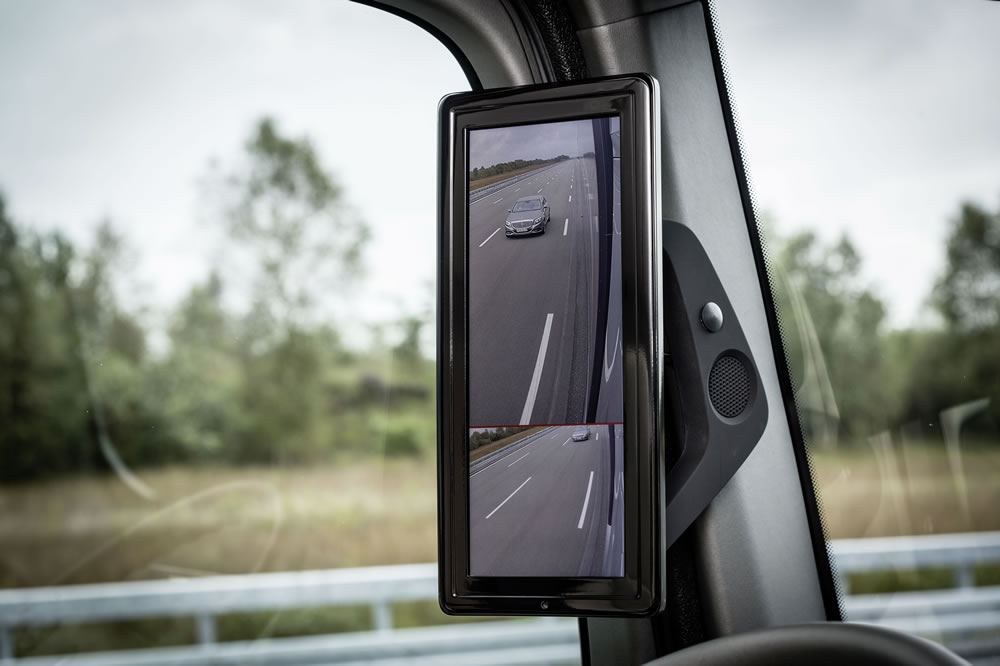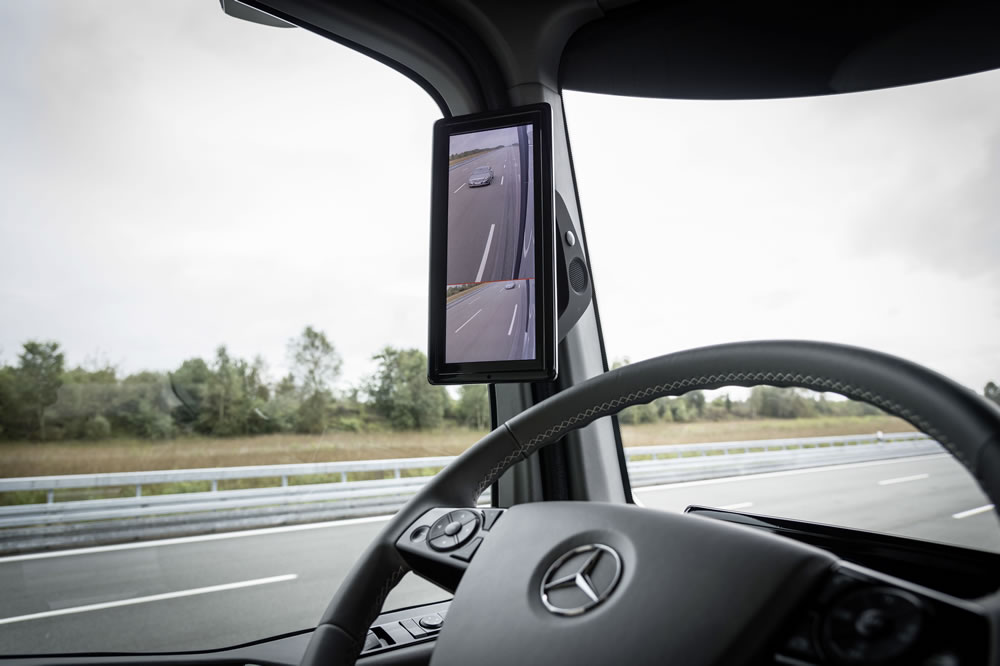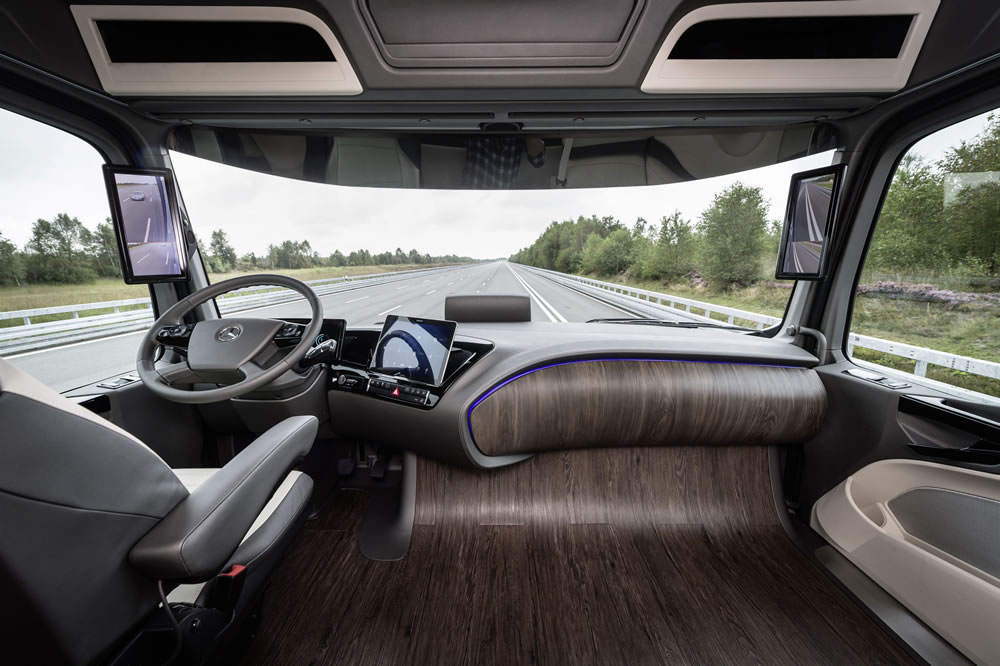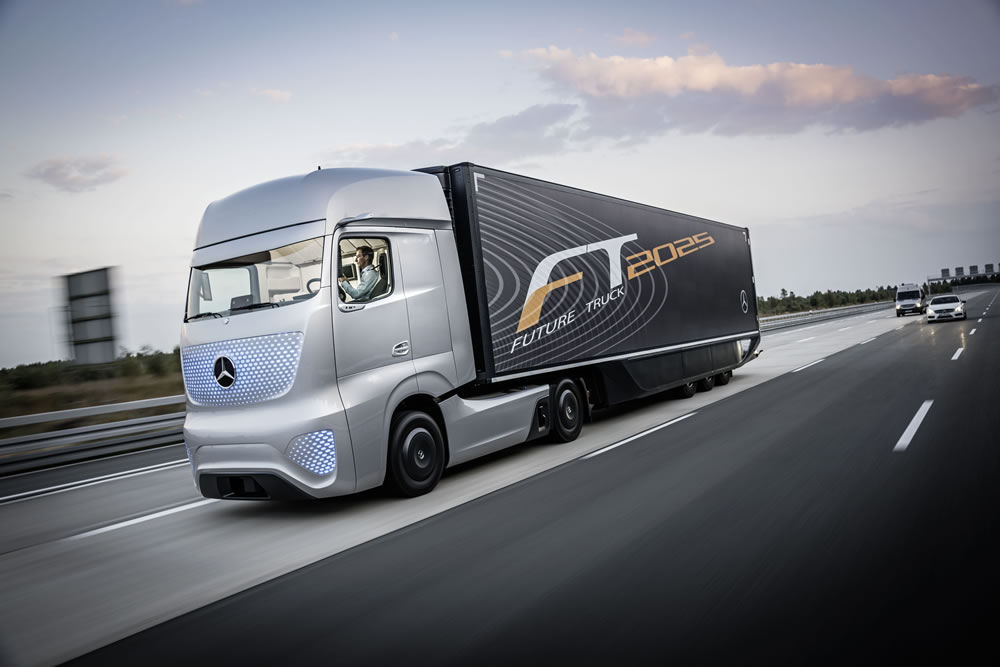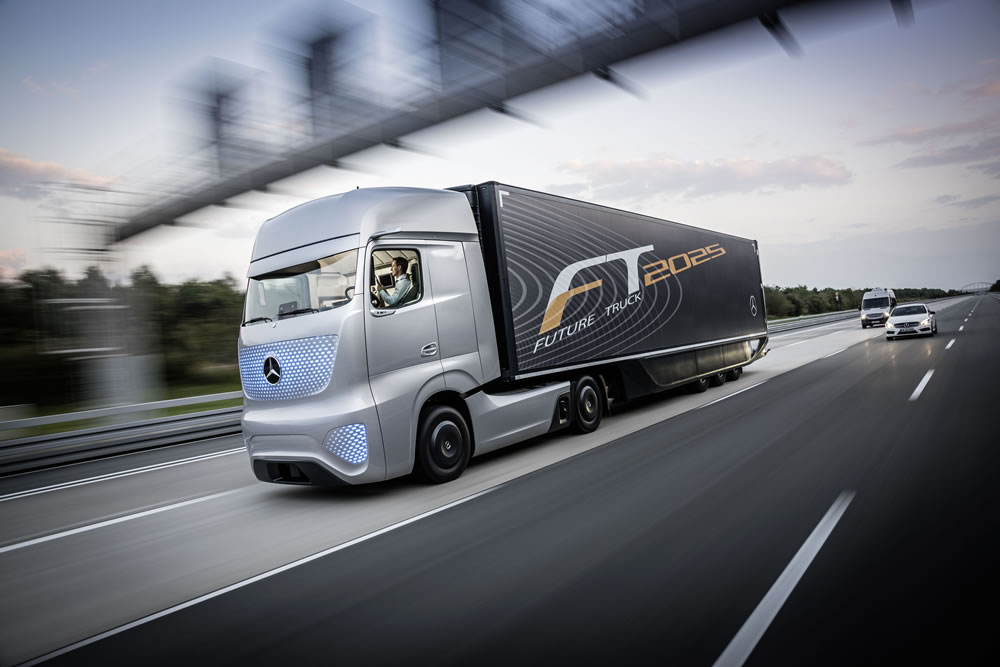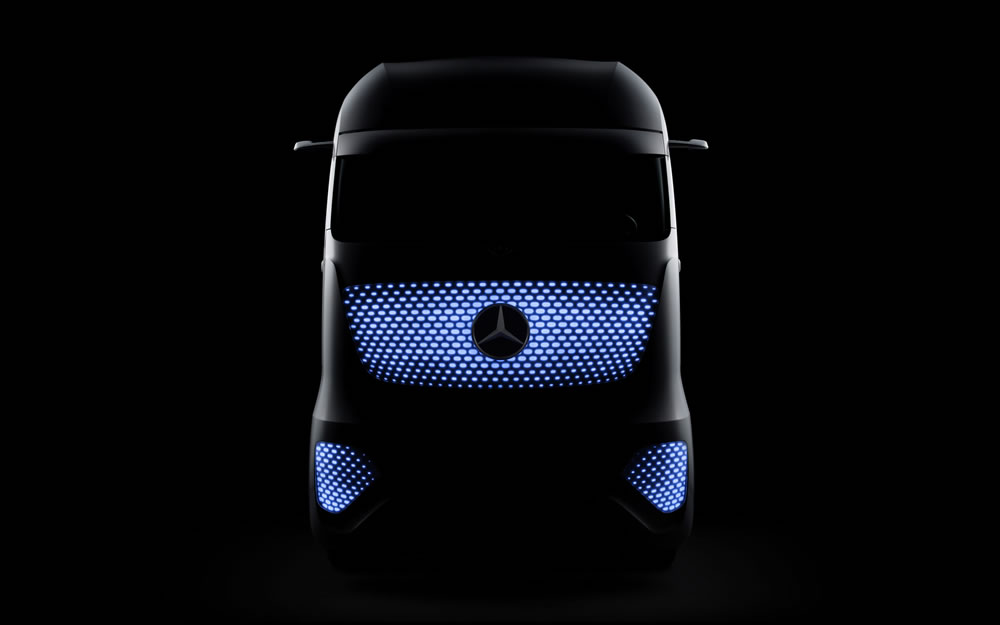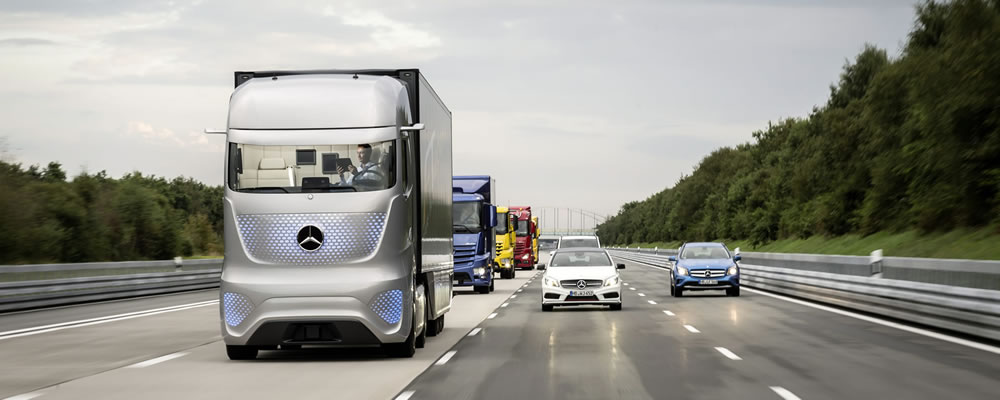Mercedes-Benz is revolutionizing the roadways, making semi-trucks safer to cars around them, more efficient and more comfortable for the driver.
From a vision to reality – the spectacular Mercedes-Benz Future Truck 2025 study will be providing a visually exciting and technically feasible take on the long-distance truck of tomorrow at the 2014 International Commercial Vehicle show (IAA). In ten years’ time, trucks could be driving autonomously on motorways. Transport efficiency will increase, traffic will be safer for all road users, and fuel consumption and CO2 emissions will be further reduced. To do this Mercedes-Benz connects existing assistance systems with enhanced sensors to the “Highway Pilot” system. Autonomous driving is already possible at realistic speeds and in realistic motorway traffic situations. The Mercedes-Benz Future Truck 2025 provides a glimpse of the future shape of trucks.

Mercedes-Benz Future Truck 2025
Revolution on the motorways: goods transport to become more efficient, safer and more connected in the future
The technology of tomorrow is already reality at Daimler Trucks. The Mercedes-Benz Future Truck 2025 constitutes a revolution in efficiency, safety and networking, a revolution for road traffic and its infrastructure, for professional driving and for the road transport sector. This is not a new truck, but rather the key element in the interconnected transport system of the future. It is being developed as part of the “Shaping Future Transportation” initiative by Daimler Trucks to conserve resources and reduce emissions of all kinds. Other aims are to ensure the highest possible level of traffic safety and to boost networking with intelligent data management considerably for tailor-made vehicle and service solutions.
The prototype demonstrated the exciting capabilities of the Future Truck 2025 back in the summer at speeds of up to 80 km/h in realistic traffic situations on a section of the A14 motorway in Magdeburg, Germany. Now the thrilling exterior and interior of that same vehicle are being revealed. The tractor unit combined with an aerodynamically optimised trailer celebrates its world premiere as a study at the International Commercial Vehicles show (IAA).

Exterior: flowing forms with a light show
In terms of design, the Mercedes-Benz Future Truck 2025 study combines function, efficiency and emotion in a fascinating way. It adheres to the Mercedes-Benz design philosophy of “Sensual Purity”. Soft, slightly curved surfaces that are near-natural represent both efficiency and emotion. Inside and outside, the exceptional visual appearance symbolises the great leap from classic truck to autonomous transport vehicle of the future. Innovative forms and the lighting engineering of tomorrow send the conventional truck cab into the future.
The designers have leveraged the opportunity presented by future length specifications: extending the front section allows soft, aerodynamically flowing forms to be created. Visual effects from the paintwork in light silver emphasise the enticingly smooth contours. Compact cameras replace conventional exterior mirrors. Its windscreen resembles a visor. The study’s integral sun screen and aero roof have a distinctive form.
Featuring signature Mercedes-Benz style, the design is composed around the star as the central element. Looking practically seamless and as if made of one piece, the cab exudes maximum calm. Its plain yet powerful appearance lends it an imposing monolithic air.
While at a standstill with the engine switched off the front mask is closed. Classic elements such as the headlamps seem to be missing at first glance. The Future Truck 2025 comes to life when the engine starts. LEDs illuminate the surfaces and light up the paintwork. The front mask gleams and LED bulbs shine instead of conventional headlamps to the left and right in the bumper. Orange flashing lights indicate when the truck is changing direction.
When the fully drivable study is being controlled manually and on the move, the lights are white. When the truck is driving autonomously, the colour of the lights changes from white to blue. They then pulsate strongly, thus symbolising the truck’s powerful heartbeat and clearly indicating the vehicle’s current operating mode to other road users.

Mercedes-Benz Future Truck 2025
Interior: calming design for a new way of working
The sensual purity of the Future Truck 2025’s calming design is also reflected by the interior. Flowing lines from the exterior are taken up again inside the cab.
Mercedes-Benz already creates a visual separation between the areas for driving and living in the cabs of long-distance transport. In the future the cab will also include a more comfortable and functional working area for autonomous driving phases.
The interior of the Future Truck 2025 is compelling as the focus is on essential functions and the design is almost puristic. The workplace for driving is calm and uncluttered like a modern, paperless office. Utilitarian engineering is excitingly juxtaposed with natural materials and a feeling of cosiness and warmth.
Wood flows from the floor to the instrument panel with generous use of the material underlying the inviting atmosphere and sense of well-being on board. The dark finish is strongly grained, open-pore and has a naturally aged effect – a welcome contrast to the high functionality of the working area.
The instrument panel is calm and uncluttered, with displays separating instruments and the exterior mirrors. They float like islands over the piano lacquer finish in the cockpit. Instead of conspicuous air outlets there is indirect climate control with a touchpad replacing conventional switch strips. The support for the instrument panel is clad in leather. Perfect craftsmanship and build quality sit side by side with the functional character of the truck’s technical features.

Mercedes-Benz Future Truck 2025
Exciting lighting effects inside the cab also underline the distinctive character of the Future Truck 2025.
When the truck is travelling autonomously, the driver may recline their seat and also turn it by 45 degrees into the space, allowing them to consciously adopt a relaxed, comfortable working position. At the same time, indirect lighting illuminates the interior without glare.
To communicate from the future workplace the driver uses a tablet computer. This is accommodated in the newly designed centre console but is removable. Here the driver can process documents, schedule more destinations, accept further orders and arrange the next break. The computer screen can be configured to suit individual requirements, also enabling the driver to call up all key trip data.
On long routes driven autonomously, the tablet computer becomes as crucial as the steering wheel and pedals are otherwise. The Mercedes-Benz Future Truck 2025 ushers in a new way of working in the cab of a long-distance truck.
As an overall concept it combines the high-tech driver’s area of the future with a state-of-the-art, paperless office and a living room. The driver in the Mercedes-Benz Future Truck 2025 feels at home even when on the move thanks to the digital picture frame on the cab’s rear panel: here personal photographs of family or a past holiday scroll through on the screen. Despite all its functionality and efficiency, this high-tech truck also shows emotion.

Mercedes-Benz Future Truck 2025
Radar sensors and a camera scan the surroundings
The technology behind this exciting façade is no less impressive. The Mercedes-Benz Future Truck 2025 is not, for instance, part of a platoon. It does not need to be daisy-chained to other vehicles either. Radar sensors and camera technology enable the Future Truck to drive autonomously, independently of other vehicles or central control stations. Its technical features are thus crucial in giving the Mercedes-Benz Future Truck 2025 its outstanding capabilities as an autonomous vehicle. For Mercedes-Benz the culmination of this is the highly intelligent “Highway Pilot” system, which resembles the autopilot on an aircraft. Networking with other trucks or passenger cars extends its abilities further, but is not necessary for autonomous driving.
A radar sensor in the lower area of the front end scans the road ahead at long and short range. The front radar sensor has a range of 250 m and scans an 18-degree segment. The short-range sensor has a range of 70 m and scans a 130-degree segment. The radar sensor is the basis for the proximity control and emergency braking safety systems already available today.
A stereo camera installed above the instrument support behind the windscreen keeps the area ahead of the vehicle in view. This is currently the location of a mono-camera if optional Lane Keeping Assist is ordered. The range of the stereo camera is 100 m, and it scans an area of 45 degrees horizontally and 27 degrees vertically.
The stereo camera of the Mercedes-Benz Future Truck 2025 identifies single- or two-lane roads, pedestrians, moving and stationary objects, all objects within the monitored area and also the road surface. The camera recognises everything that contrasts with the background, and is therefore also able to measure clearances precisely. The front stereo camera also registers the information on traffic signs.
In addition to object and distance recognition, the stereo camera recognises lane markings as a major function for autonomous lane guidance.
The road surface to the left and right of the truck is monitored by radar sensors installed in the sides. They are located on the left and right, ahead of the tractor unit’s rear axle. The sensors have a range of 60 m and cover an angle of 170 degrees in the longitudinal direction.

Mercedes-Benz Future Truck 2025
Blind Spot Assist: more safety when turning and changing lane
These sensors form the heart of the new Blind Spot Assist system from Mercedes-Benz. The radar sensor modules are arranged in such a way that they cover the area parallel to the truck over the entire length of a tractor/trailer combination or drawbar combination. In addition this strip is extended forwards to two metres in front of the truck.
Blind Spot Assist warns the truck driver about other road users not only when turning; it also warns about imminent collisions with stationary obstacles – for example signs or lamps – and serves as an assistance system when changing lane.
For Mercedes-Benz, the planned introduction of Blind Spot Assist over the next few years is a major step paving the way for the Future Truck 2025 and underlines Mercedes-Benz’s role in pioneering maximum road safety.
The transport system of tomorrow will be networked and autonomous
All sensors on board the Future Truck 2025 are networked (multi-sensor fusion), and provide a complete image of the surroundings. All moving and stationary objects in the truck’s vicinity are registered.
Fusion of the data by a high-performance multi-core processor in the central computer links the data from all sensors in the whole area in front of and beside the truck.
The sensor and camera technology is active from standstill to the legally permitted maximum speed for trucks. By intervening in the steering, it automatically keeps the truck safely in the centre of its lane. The system also includes a three-dimensional digital map, which is already used for the assistance system Predictive
Powertrain Control (PPC). This means that the truck is always fully aware of the road’s course and topography.

Mercedes-Benz Future Truck 2025
V2V and V2I – communication between vehicles and the outside world
The “Highway Pilot” is ideally partnered with V2V and V2I networking. Every vehicle equipped with this in the near future will transmit continuous information to its surroundings. This includes vehicle position and model, dimensions, direction of travel and speed, any acceleration and braking manoeuvres and the bend radii negotiated.
The frequency of information transfer depends on the vehicle speed and the intensity of any changes in its movement. It varies between one message per second when cruising to ten times this interval when changes are significant.
Transmission is via WLAN technology, using the standard Europe-wide G5 frequency of 5.9 gigahertz. The basis is the ITS Vehicle Station (Intelligent Transport Systems and Services) on board the vehicle.
Communication between vehicles is also standardised. The range of these continuous sent messages is a radius of around 500 m. The vehicles inform each other about their movements, so that they can respond to them immediately in anticipatory mode. This includes reacting to vehicles joining a motorway, or when approaching the end of a traffic tailback, for example. The more vehicles are communicating with each other on these routes, the more dynamically and flexibly they are able to respond to one another and together.
In an ideal scenario, an uninterrupted chain of communication forms along a route that rigorously informs the driver and vehicle about road and traffic conditions a long way ahead on their journey.
V2I means that all these messages and signals are also sent to external recipients such as traffic control centres. These are then able to respond flexibly, for example by changing the speed limit or opening up additional lanes. Messages can also be sent to vehicles, for example about temporary roadworks.
All these data inform the driver and the onboard computer about events happening outside the range of vision in good time. The driver and vehicle are therefore aware of obstacles in advance, before they can become a hazard.

Mercedes-Benz Future Truck 2025
Anti-tailback measures: road traffic as a self-learning system
The Mercedes-Benz Future Truck 2025 is therefore not on the road in isolation, but constantly communicates with its environment, unnoticed by the driver.
Traffic information are passed on in this way and the data become available to all road users. Because networked vehicles respond automatically to these data, homogeneous traffic flow is ensured along with exceptional utilisation of limited road infrastructure. In combination with autonomous driving, road traffic will develop into a self-learning system.
The average speed is thus improved by better traffic flow alone and without raising the maximum speed. At the same time, homogeneous traffic saves on fuel.
Future becomes reality: autonomous driving in practice, including independently of other road users
After joining the motorway, the driver of the Mercedes-Benz Future Truck 2025 merges with the traffic flow in the appropriate lane. The system then prompts the driver to activate the “Highway Pilot”. The driver activates it, and the vehicle switches to autonomous mode.
According to the given traffic situation, the Future Truck 2025 is on the road independently, as no vehicle in front is needed as a reference to guide it through the traffic. It acts autonomously in its lane. If there is another vehicle travelling ahead, the truck can adapt to its speed within the permitted limit and maintains a set safety distance. It is therefore always possible for other vehicles to join the lane safely. The safety distance is also always maintained – the Mercedes-Benz Future Truck 2025 adapts perfectly to its environment. The Future Truck 2025 operates independently of other road users thanks to networking. However, to fully benefit in terms of logistical efficiency and making optimum use of infrastructure, comprehensive networking is desirable. This development is certain to occur in a gradual manner. Open standards and protocols are important to this end.
From driver to transport manager in the cockpit of the future
In many situations autonomous driving relieves the driver of “having to” drive, especially on tiring and often monotonous long-distance routes. As the truck regulates its own speed and automatically finds the best route using a navigation app, and because the transport company, dispatcher and goods recipient are constantly informed about the location, route and expected time of arrival in real time, the driver is relieved of time pressure. Today this is a major stress factor for drivers.
The driver gains time for other activities and is able to communicate with his surroundings. It is conceivable that the driver will be able to take on tasks previously performed by the scheduling team or which provide social contact. Owner-driver businesses in particular will be able to perform office tasks conveniently on the move if required.
Carrying out further activities will significantly change the professional profile of the truck driver. This will in turn give rise to opportunities for advancement from the purely driving role to transport manager. The profession of truck driver will become more attractive – autonomous driving is therefore also a compelling answer to the shortage of drivers. With autonomous driving, the truck and its driver become a team more than ever before, an intelligent, highly capable and cost-effective combination of man and machine.

Mercedes-Benz Future Truck 2025
Consumption and emissions down – efficiency and safety up
At the same time fuel consumption and emissions are significantly reduced during autonomous driving, thanks to the more homogeneous traffic flow. Transport times will become more predictable. The new activities carried out by the driver or transport manager during journeys will revolutionise the freight forwarding sector, making it a dynamic and self-learning system.
Traffic flows on long-distance routes that are predictable for all road users mean more safety for all those involved. Already, assistance systems regulate vehicle speeds and are able to automatically initiate emergency braking to prevent accidents. Both have proved their worth for a number of years. Autonomous driving stands for perfection by fusion of the assistance systems.
In the future, accidents caused by human error will therefore be largely a thing of the past. Safety regulations such as speed limits or safety gaps between vehicles will always be strictly adhered to. Anticipatory driving, a recurring theme in driver training courses, means programmed safety and cost-effectiveness for the Mercedes-Benz Future Truck 2025.
Autonomous driving: set to become reality in the short term
One of the most interesting questions on the subject of autonomous driving is the time horizon envisaged for its realisation. In purely technical terms, turning it into reality on the roads is already feasible within around five years. In terms of passenger car development cycles, a possible start is envisaged in 2020. Owing to the more complex factors for heavy commercial vehicles, the time horizon for such vehicles will, however, be rather longer – realistically implementation is possible within ten years, also in view of the legal considerations that still remain to be clarified.
The introduction of autonomous driving will not happen digitally from one day to the next, as development is progressing in a gradual manner: evolutionary stages are necessary to revolutionise goods haulage on the roads. In the coming years, new and improved assistance systems will continue to pave the clearly set-out way to autonomous driving.

Mercedes-Benz Future Truck 2025
Conditions necessary for autonomous driving
The technical preconditions are now being demonstrated for the first time with the Mercedes-Benz Future Truck 2025; however legislation also needs to be adapted to this new dimension in driving. A further development of the “1968 Vienna Convention on Road Traffic”, which almost all European countries have signed and implemented, is already under way. The Convention is intended to make road traffic safer by standardising regulations, and one of its core principles is that the driver must have control of the vehicle at all times and in all circumstances.
On the basis of the Vienna Convention on Road Traffic, UN/ECE Regulation R 79 does permit corrective steering intervention for steering systems, but not automatic steering over 10 km/h. This allowance is a precondition for Parking Assist and Stop-and-Go Assist.
The Vienna Convention came about at a time when autonomous driving was still in the realms of science fiction. A committee of United Nations experts has recently supplemented the Vienna Convention on Road Traffic, providing the basis for legalisation on autonomous driving. Corresponding systems will be permitted in the future, as long as they can be deactivated or overruled by the driver at any time. This is standard for the “Highway Pilot” in the Mercedes-Benz Future Truck 2025.
Data security must also be ensured in technical and legal terms. This concerns external access to the individual vehicle, and also the transfer of data for V2V and V2I or internet communication.
In addition to operating permission it will be necessary to clarify other legal aspects such as liability for traffic infringements and accidents, which can never be completely ruled out. The same applies to insurance and product liability aspects. How new working models and professional profiles are to be reconciled with the current regulations on driving and resting times also remains to be defined.
The answer: Mercedes-Benz Future Truck 2025
Where the associated legal steps are taken, the Mercedes-Benz Future Truck 2025 with the “Highway Pilot” system is the answer to the challenges of the future. The answer to increasing traffic, inadequate infrastructures, increasing cost pressure and a shortage of drivers. Against the background of numerous new and enhanced assistance and telematics systems and V2V/V2I communication, a new era in road goods transport and communication is being ushered in. In the future traffic will flow more smoothly, predictably and safely. Traffic systems will become more flexible, with better use of the infrastructure. Avoidance of human error at the wheel will reduce hazards and accidents. Transport operators will operate more cost-effectively and flexibly. Truck drivers will be able to assume different tasks as transport managers. This answer to the many challenges is not just a vision, it is already reality.

